Tomorrow, the world’s eyes will turn to the semi-final matches of the Africa Cup Of Nations, after a tournament full of excitement and surprises, where firstly, Nigeria will meet South Africa, and then Ivory Coast will face the Democratic Republic of Congo.
Nigeria advanced from their group as second behind Equatorial Guinea. After that, they defeated Cameroon and Angola in the knockout stages while South Africa advanced as second in Group E behind Mali in a group that included Tunisia and Namibia. After that, They defeated Morocco and Cape Verde in the knockout stages.
Ivory Coast advanced from Group A as third among the best four third-placed teams in a group that included Equatorial Guinea, Nigeria and Guinea-Bissau. Then, they defeated Senegal on penalties and Mali in the 120th minute in the knockout stages. Congo advanced as second in Group E after Morocco in a group that includes Zambia and Tanzania. They defeated Egypt on penalties and then Guinea in the quarter-finals, and perhaps you noticed that no team that topped its group could reach the semi-finals in this exciting tournament.
In this tactical analysis, we will take a look at the most important tactics of the four AFCON semi-finalists, explaining their strengths and weaknesses. We will also explain what they intend to do in attack and defence while highlighting the influential players in their journey throughout the tournament.
Nigeria
Nideria’s attack was excellent in AFCON qualification. They scored 22 goals, far from the second, Mali, who scored 15 goals. They depended on 4-4-2 or 4-3-3 as the primary formation, but in the first match of the tournament, they drew 1-1 with Equatorial Guinea. Although they were good going forward, their pressing system wasn’t successful. Let’s see why!
As shown below, they press with a 4-3-3 shape, asking one of the two attacking midfielders, Alex Iwobi in this case, to go forward, with Victor Osimhen pressing the other centre-back. At the same time, the two wingers stand narrow, ready to press the opponent’s full-backs. Equatorial Guinea’s shape in the build-up was 4-2-3-1 with two wide full-backs and narrow wingers.
Their number ten holds Nigeria’s six away, so Equatorial Guinea’s two pivots are against only one Nigerian midfielder, which makes Iwobi hesitate to press and also forces the far winger to keep narrow to help. Hence, the goalkeeper passes a long ball directly to the wide full-back while the winger keeps the Nigerian full-back narrow, as in the second photo below.
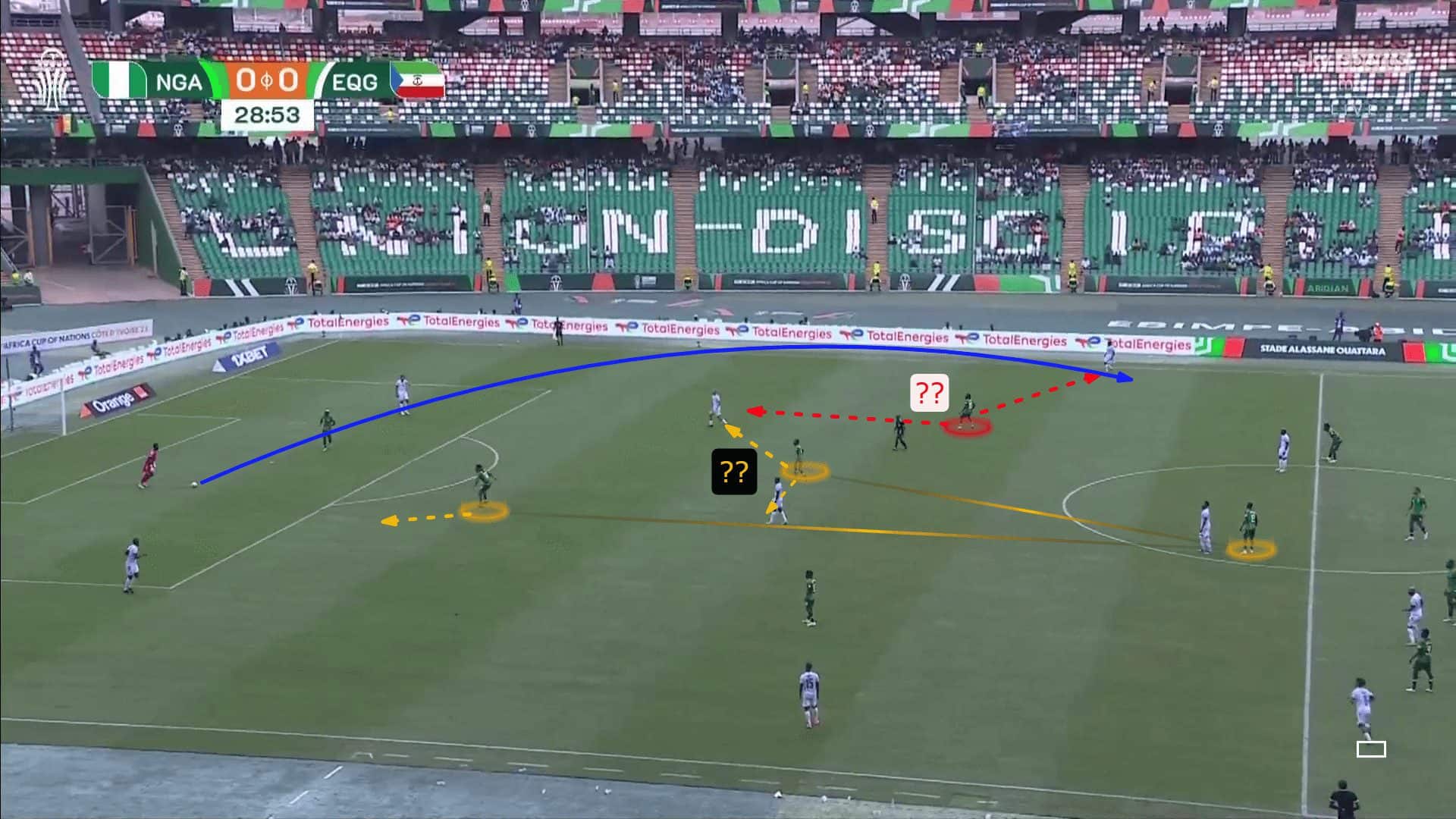
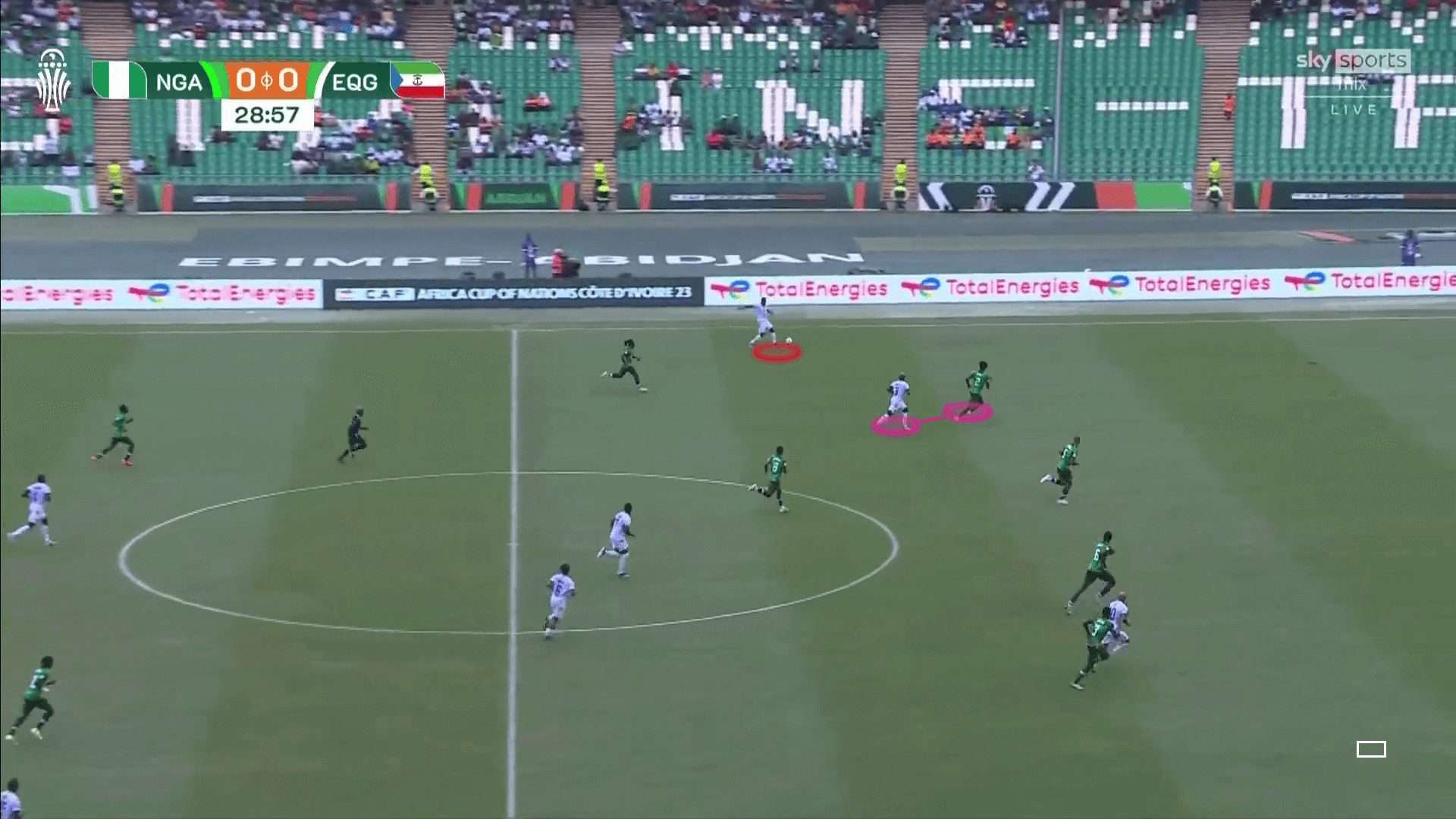
This puts Nigeria against two choices. Either to have their pressure broken, as in the case above or to step back at a mid or low block, as in the case below, where you find the three players behind the centre-forward stand narrow. The centre-forward moves horizontally behind Nigeria’s three midfielders to drag Nigeria’s 6, so you can see two highlighted players, in black, hesitating how to deal with that, so the far midfielder joins the centre.
This gives Equatorial Guinea time the ball to pass the ball in the other direction, Forcing Nigeria to stand in a low block, as in the second photo below.
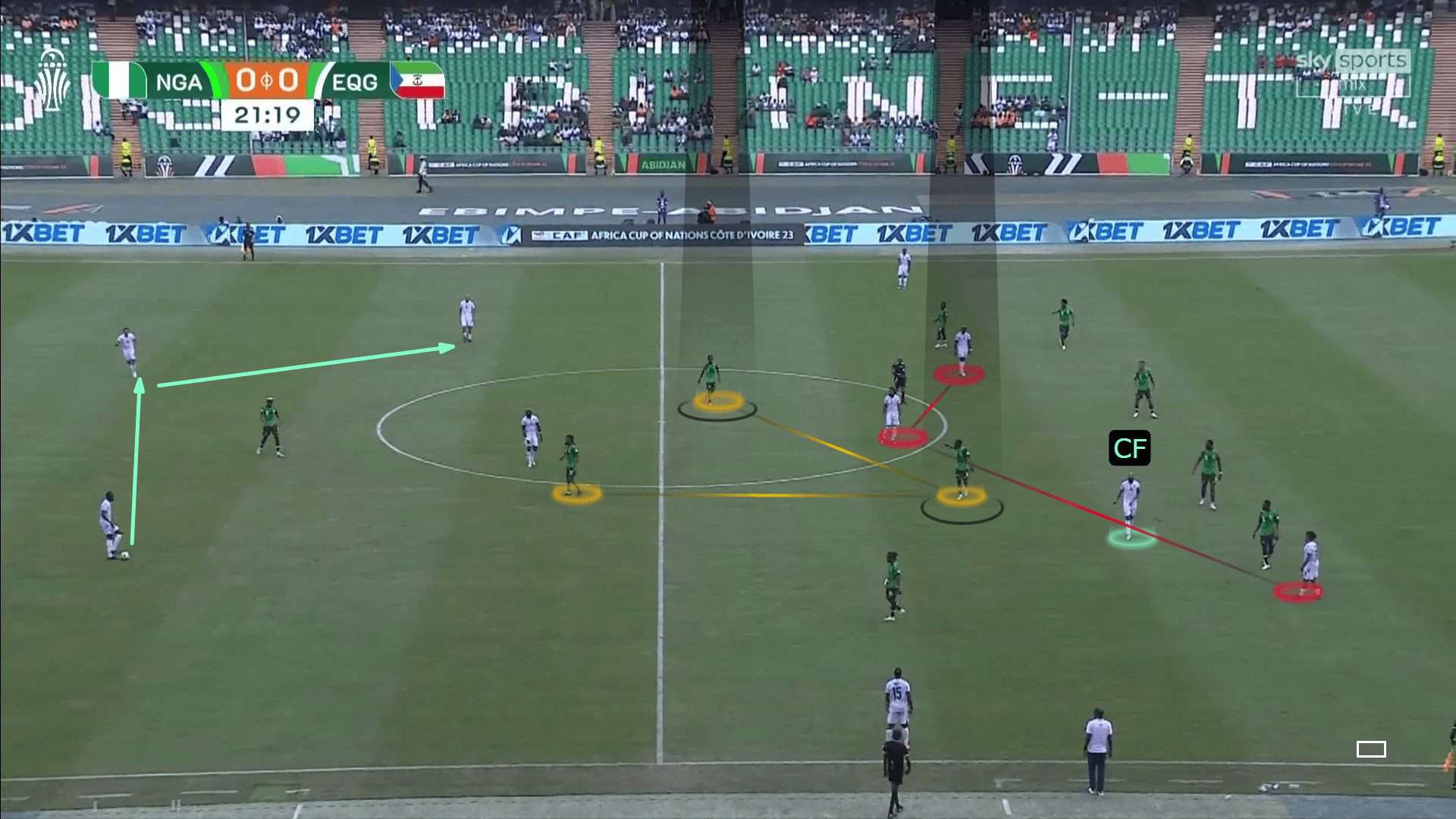
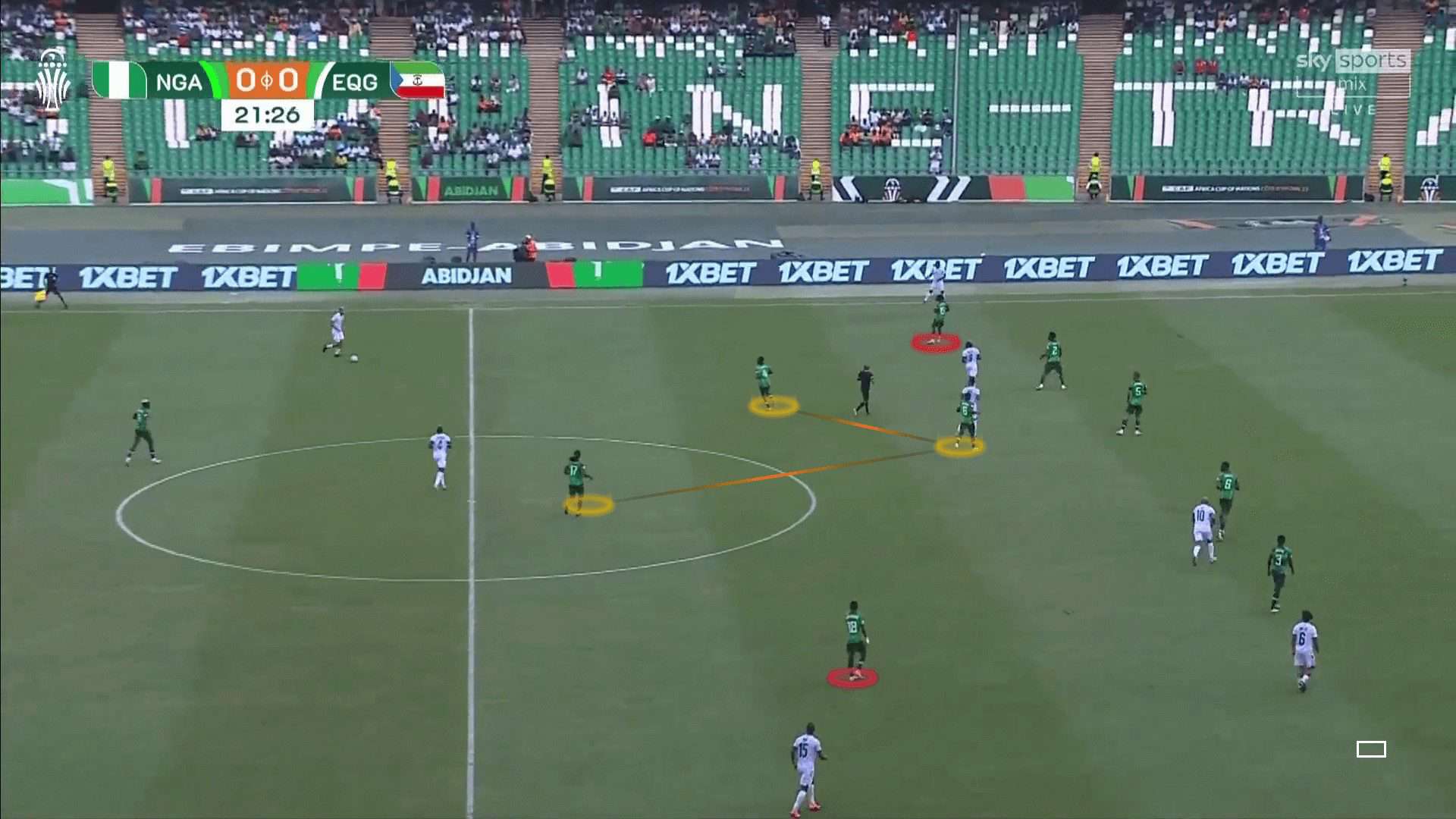
After that, they decided to turn to 5-4-1 in a mid or low block, as shown below, and they continued in this shape until this moment. They now have the best defence in the tournament, with only one goal conceded at present.
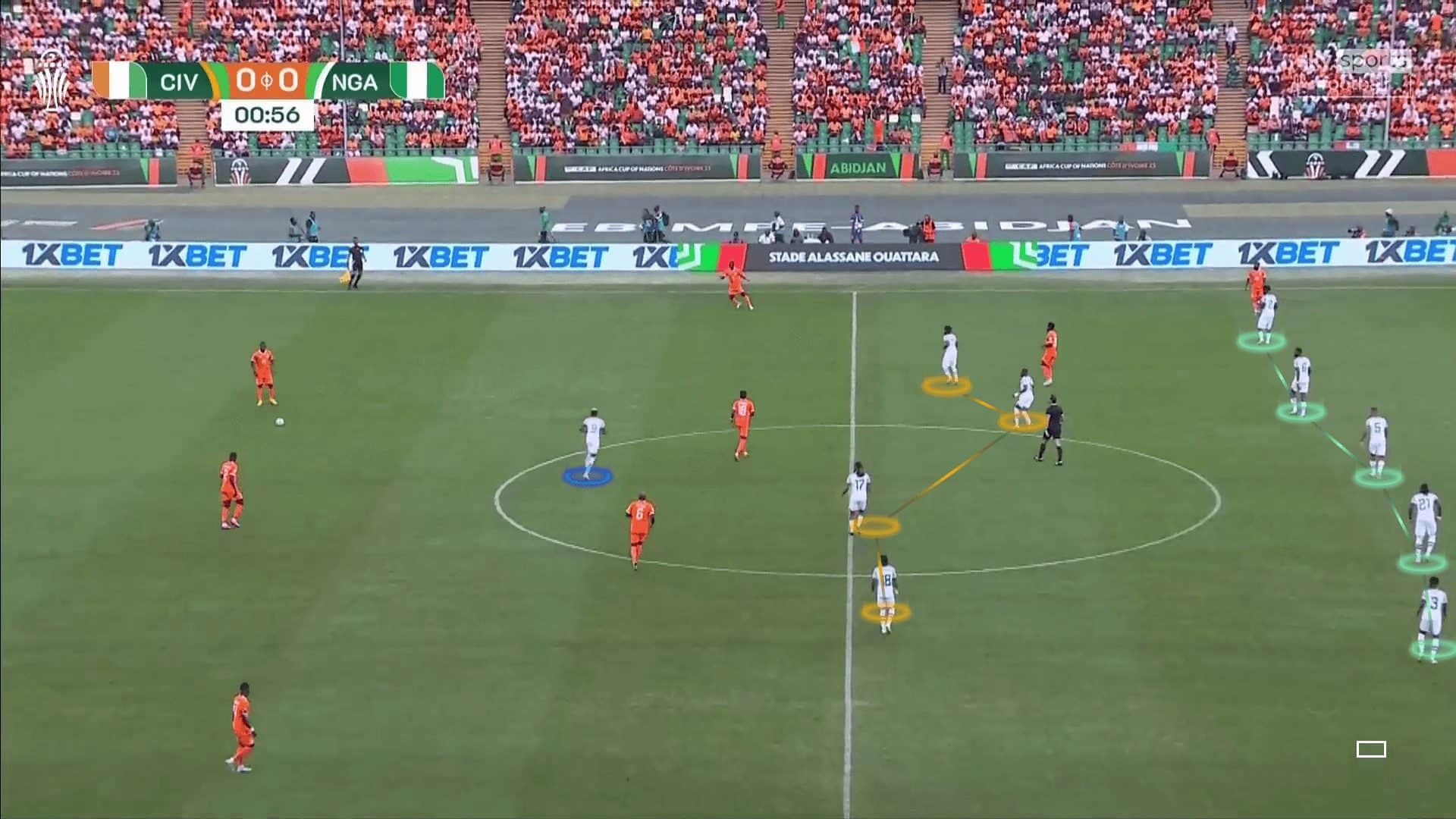
In attack, naturally, it turns to 3-4-3 with two wing-backs standing wide and three narrow forwards, Ademola Lookman, Moses Simon and Victor Osimhen, on whom they mainly depend, participating in most of their goals.
As shown below, they directly target the wing-back on the flank while the wide attacker holds the opponent’s full-back, who is forced to press the wing-back, giving the inside forward a chance to run behind him in the half-space, as shown in the second photo below.
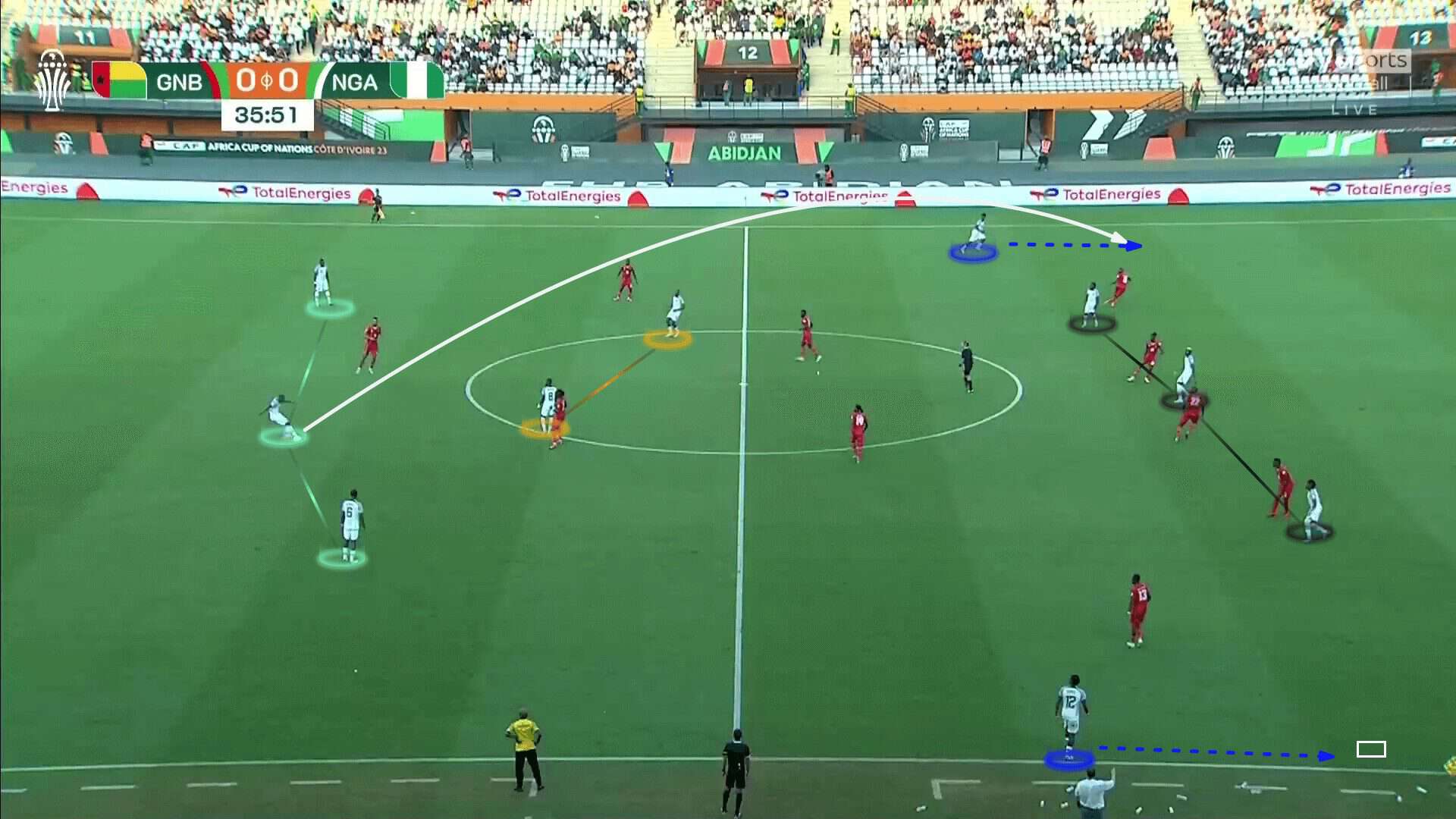
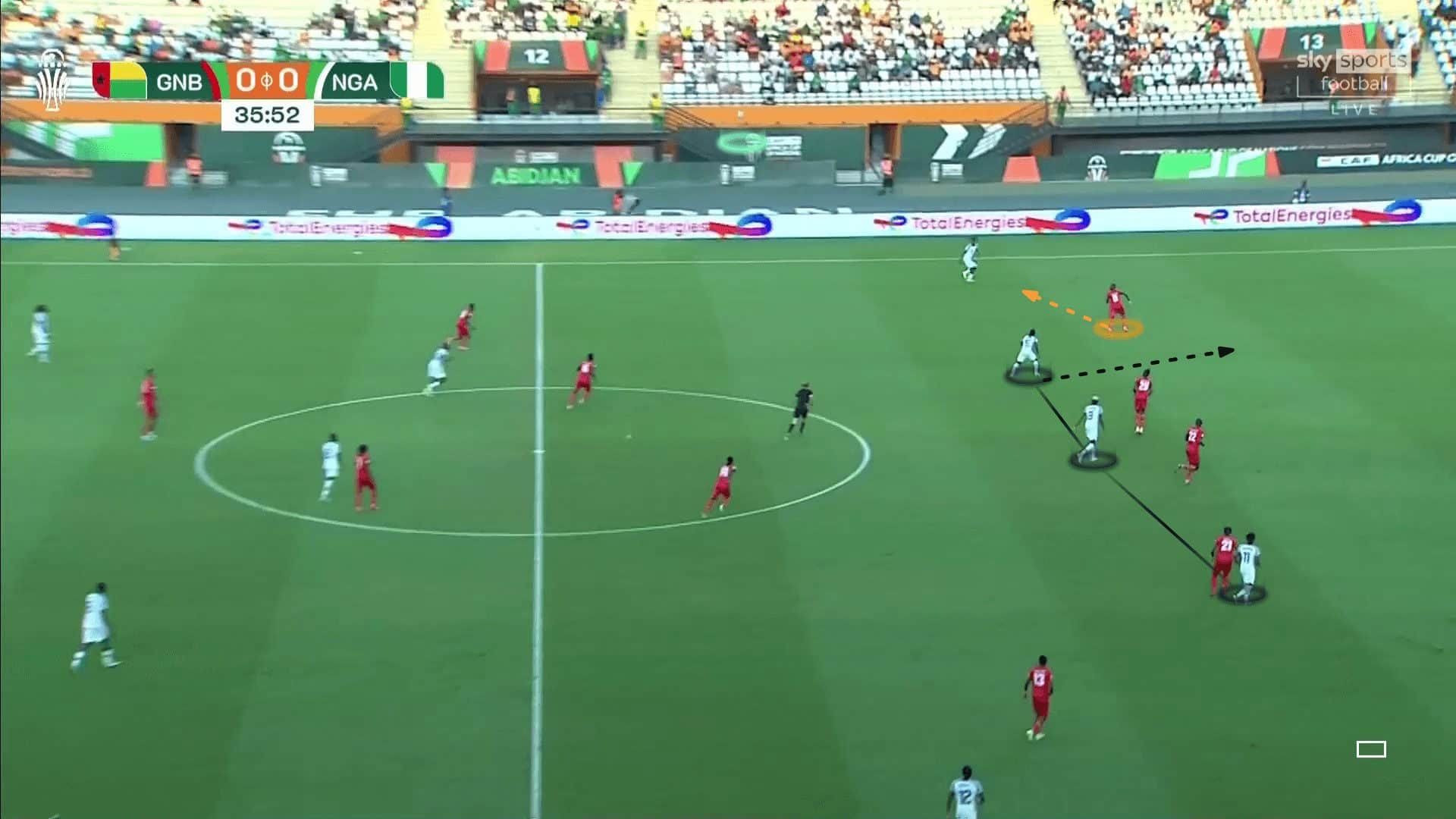
After that, Victor Osimhen runs to the goal with the defender while the other inside forward runs inside, ready to receive a cut-back pass.
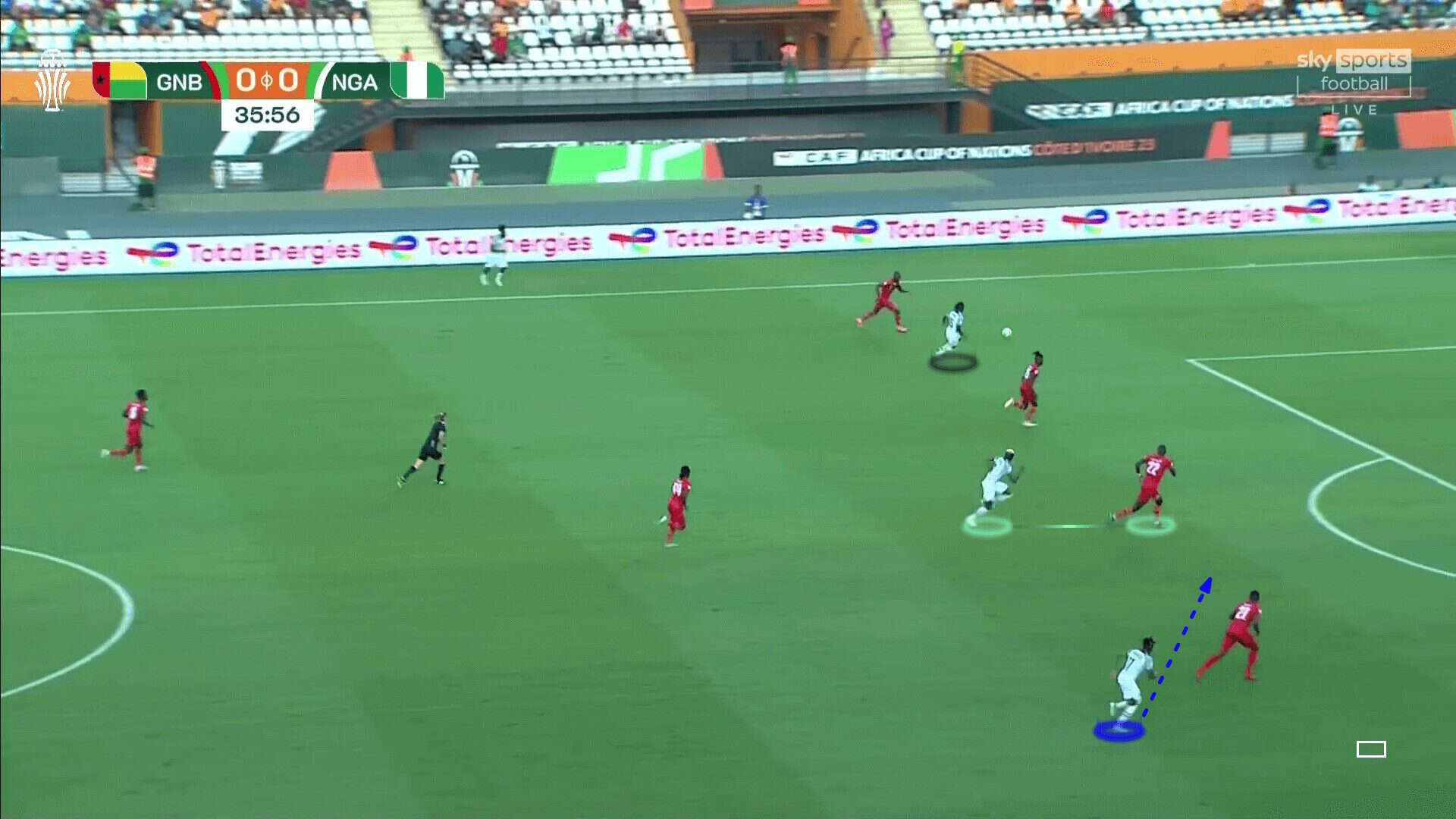
In this case, Victor Osimhen was the targeted player, but it hits the defender to be an own goal.
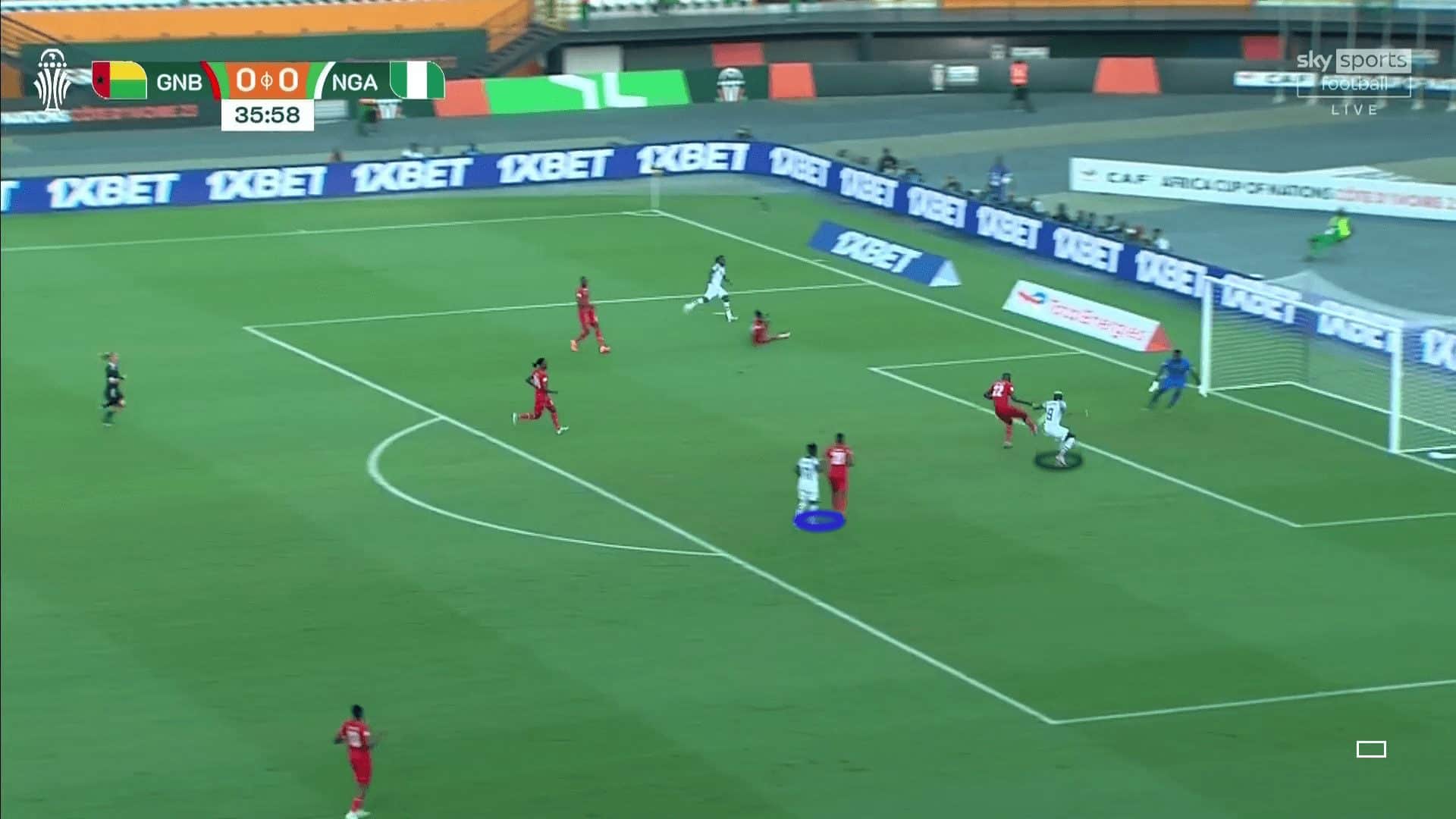
They used the same idea against Angola when they changed direction quickly to the other side, and the same sequence was done, but the far inside forward received a cut-back pass, scoring a goal.
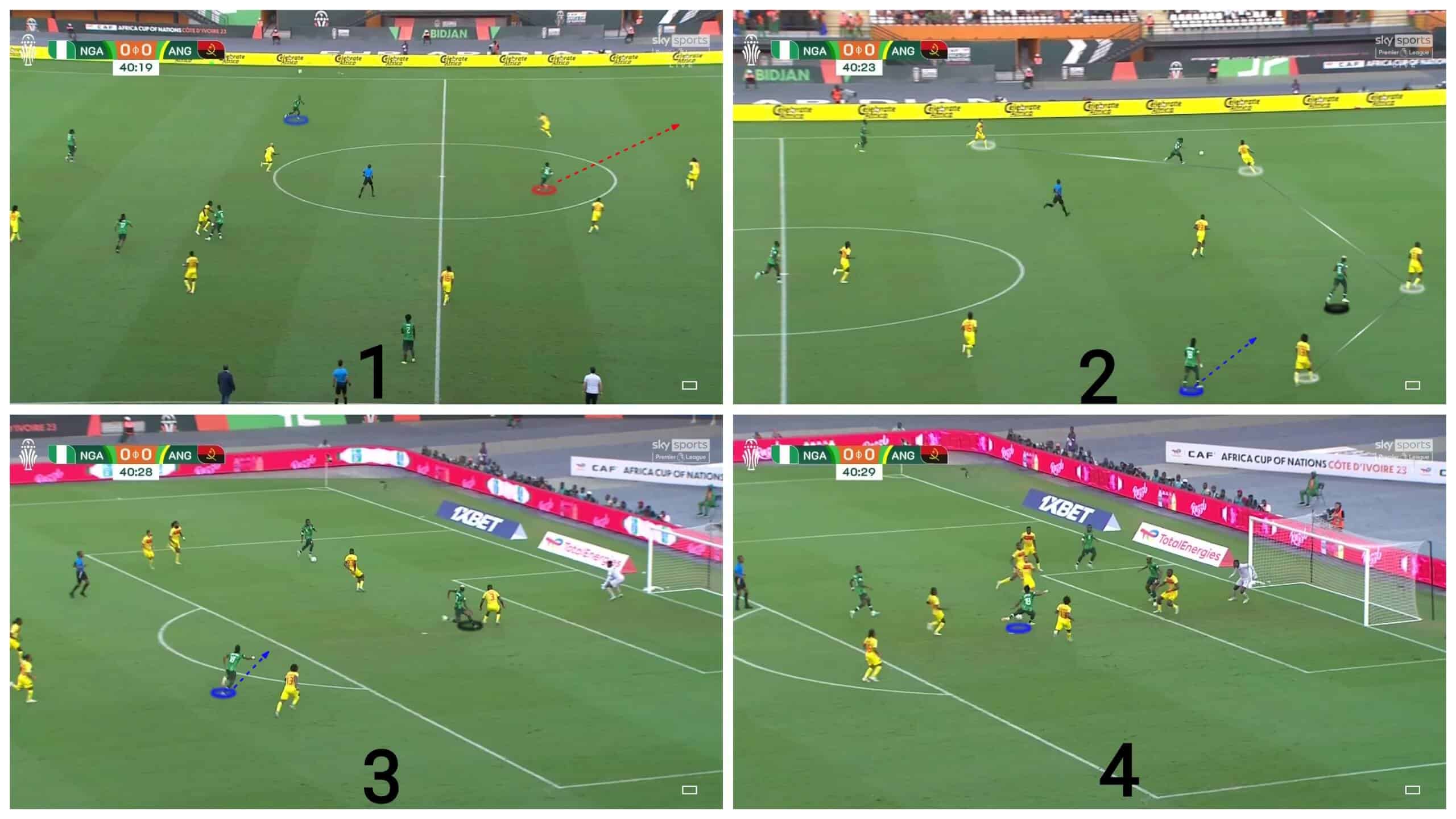
South Africa
South Africa’s team has eight players from Mamelodi Sundowns, familiar with the same philosophy of play, which kindly leans towards relational play, polar to positional play, where players have more freedom to form relations between each other and have self-organising awareness.
You can see below that they depend on 4-2-3-1 with two high and wide full-backs and narrow three players behind the strikers. One of their patterns is making the midfielder near the ball, usually their maestro Teboho Mokoena, drop in the full-back’s place when he has time and place to send long balls to the empty flanks, as shown in the two photos below or breaking-line passes.
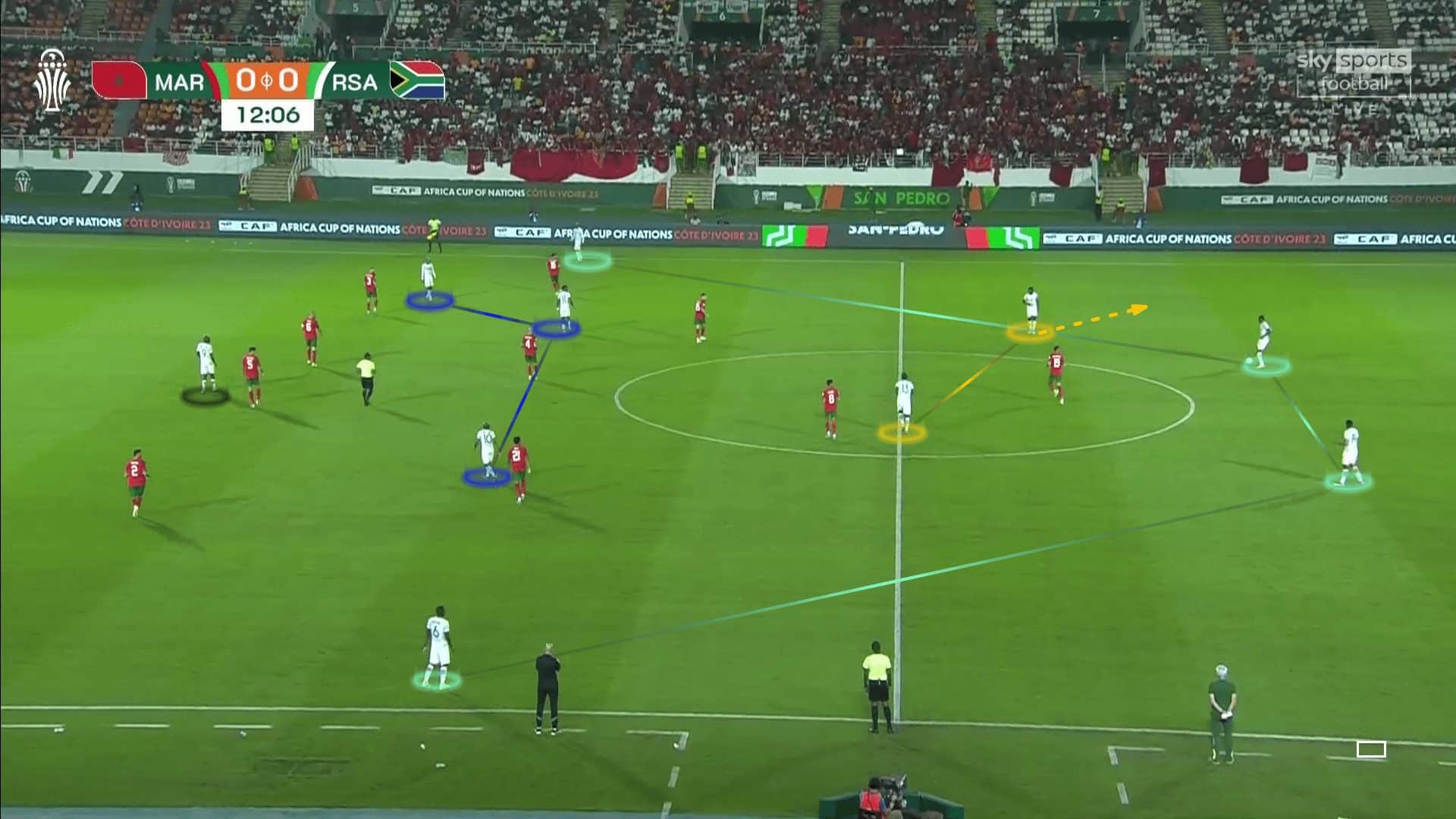
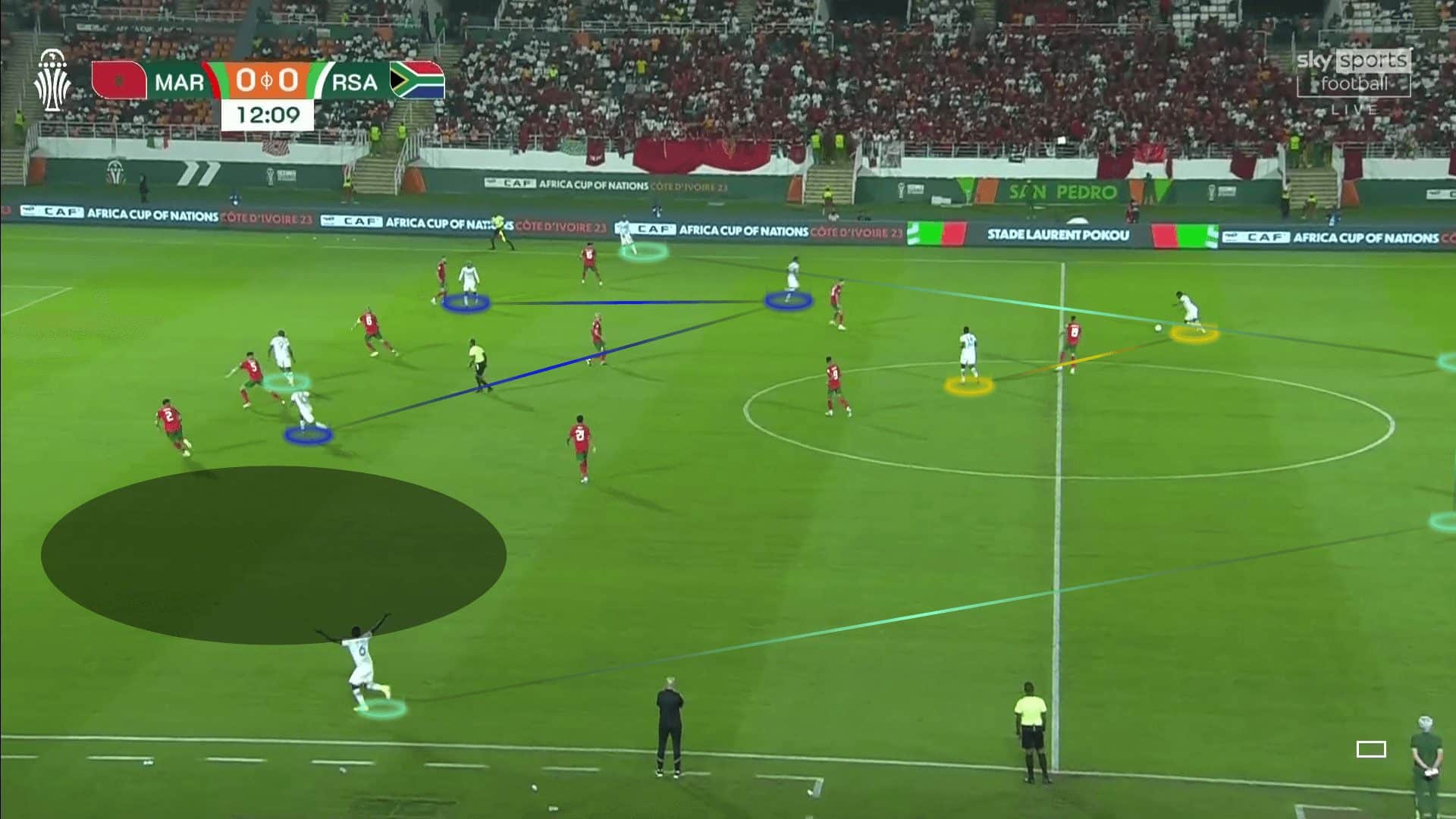
As explained, they don’t stick to certain patterns, so you can find the full-back near the ball in his place while the far pivot joins player number 10 to be likely in a 4-3-3 shape, as shown in the first photo below. With a third-man pass, they reach the far defender, who sends a long ball to the wide full-back, putting the opponent’s full-back in a 2-v-1 situation.
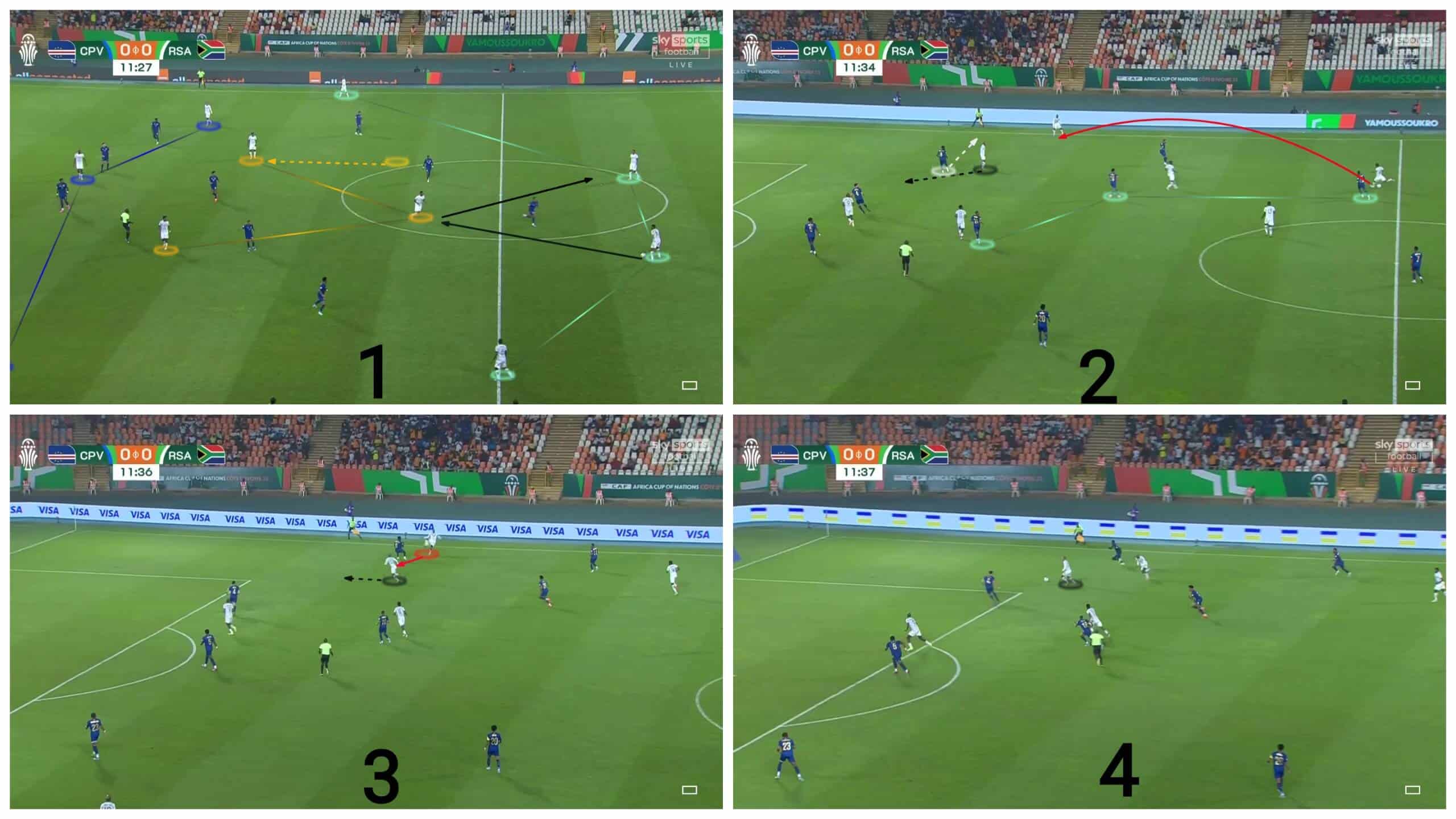
In another case below, player number 6, Sphephelo Sithole, receives the ball, amazingly shielding his ball well. Then, he passes the ball to player number 10, as shown in the first two photos. In the third photo, you find what we want to highlight to prove that they aren’t sticking to their positions, so you can see the far winger come to the ball to achieve sudden numerical and positional superiorities which gives them the chance to implement good wing rotations, as in the fourth photo.
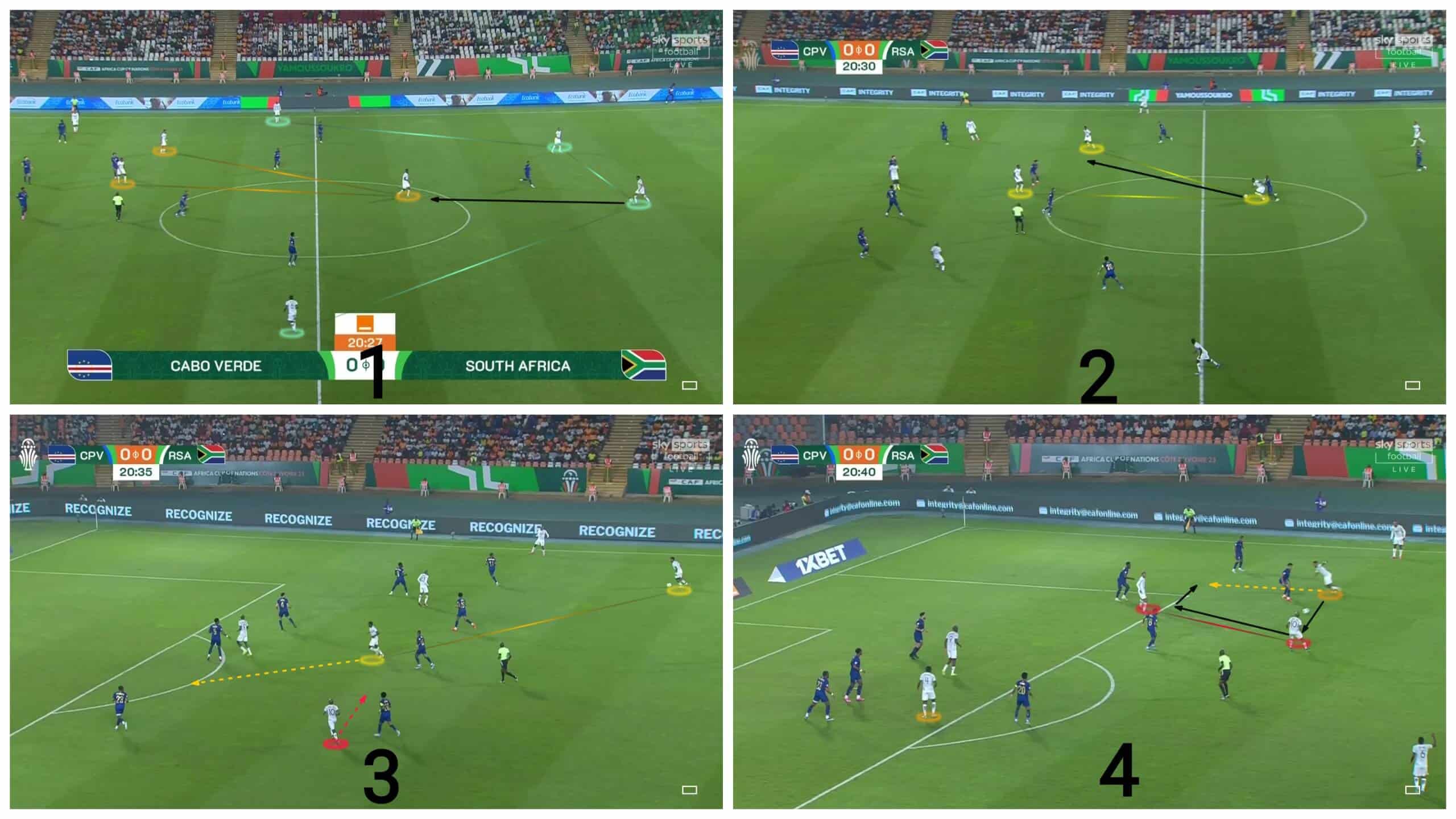
They have the ball inside the box in a good situation thanks to this sudden movement.
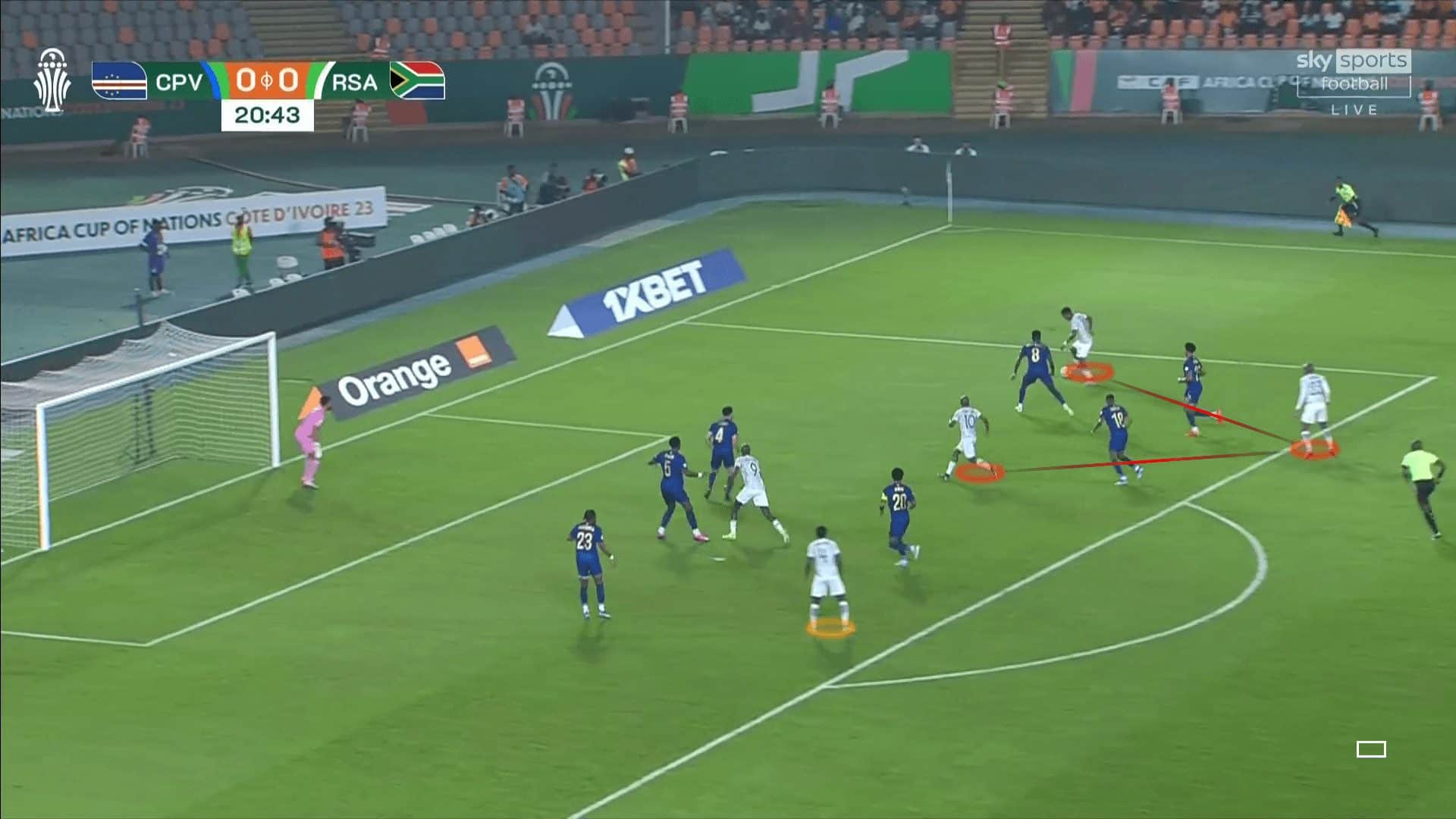
In defending, they use side pressing with a 4-4-1-1 shape, asking the centre forward to prevent the direction from being changed to force the opponent to send a long ball.
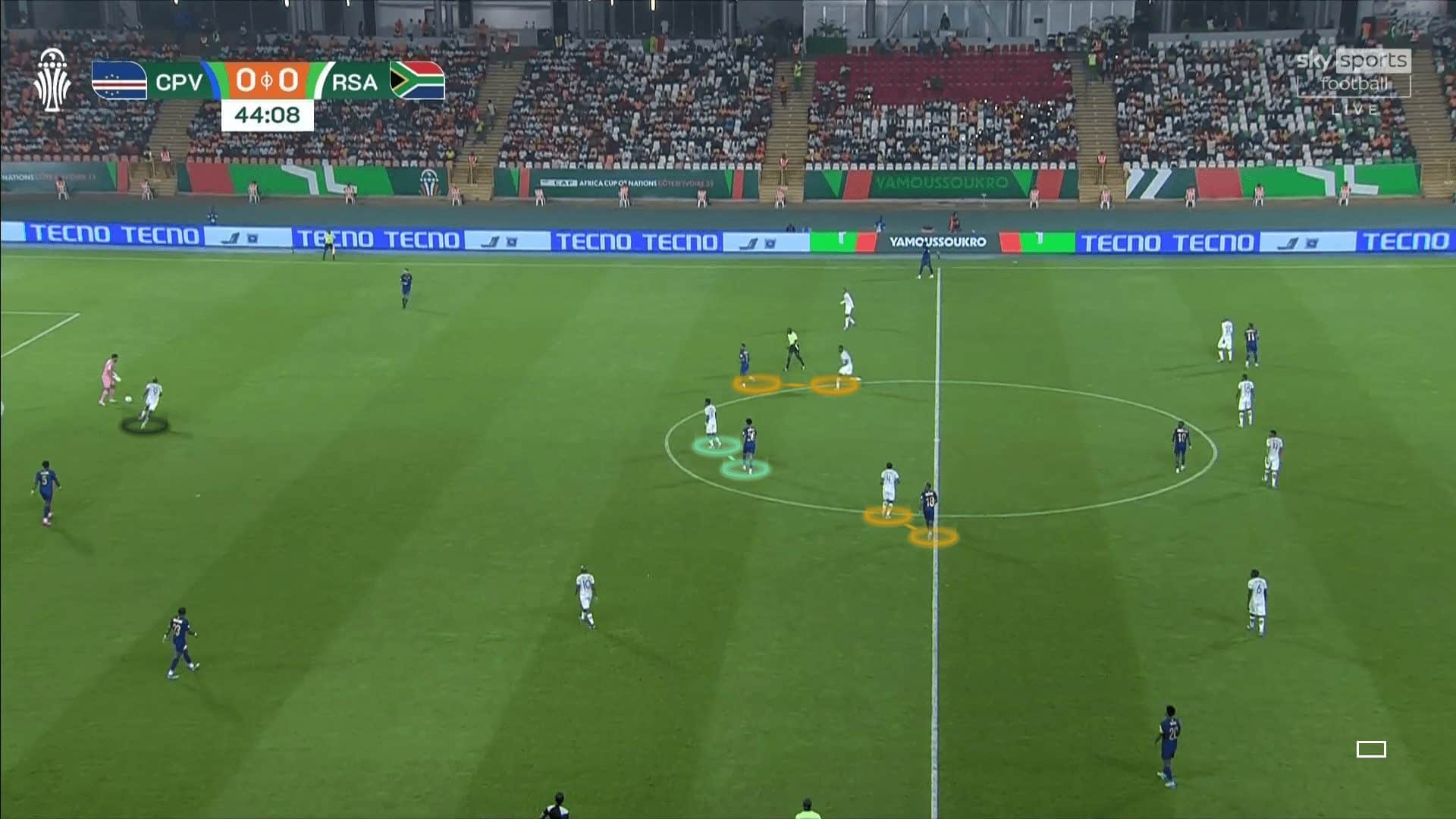
Although the opponent’s striker intends to run to the empty space behind the full-back, the defender is ready with a good body shape.
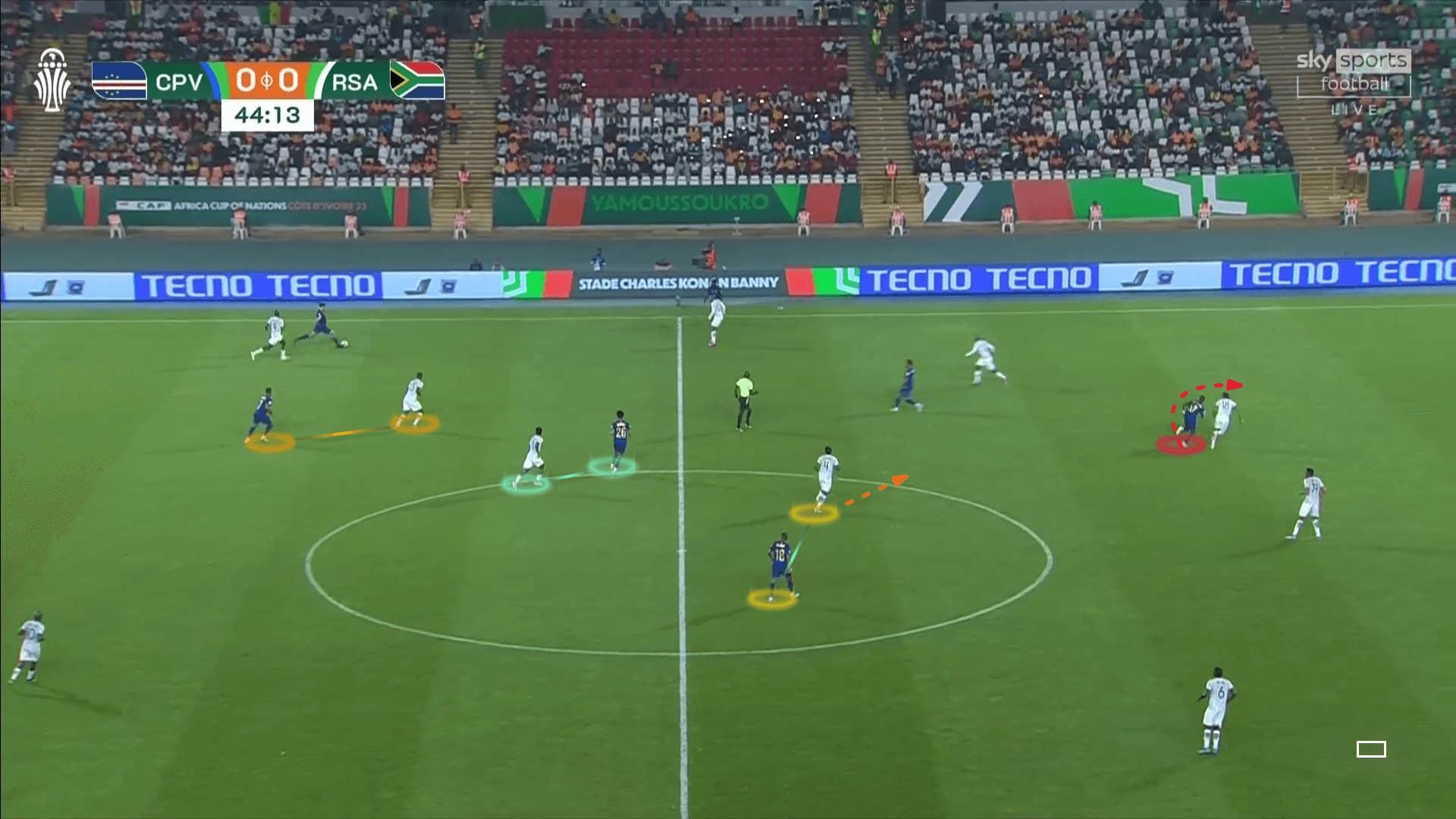
Sometimes, they rely on a 4-4-2 shape to implement six-centre-back pressure by asking one striker to press the defender while the other stands with the holding midfielder. The opposite happens when the ball goes to the other defender, especially in their match against Morocco, shown in the two photos below.
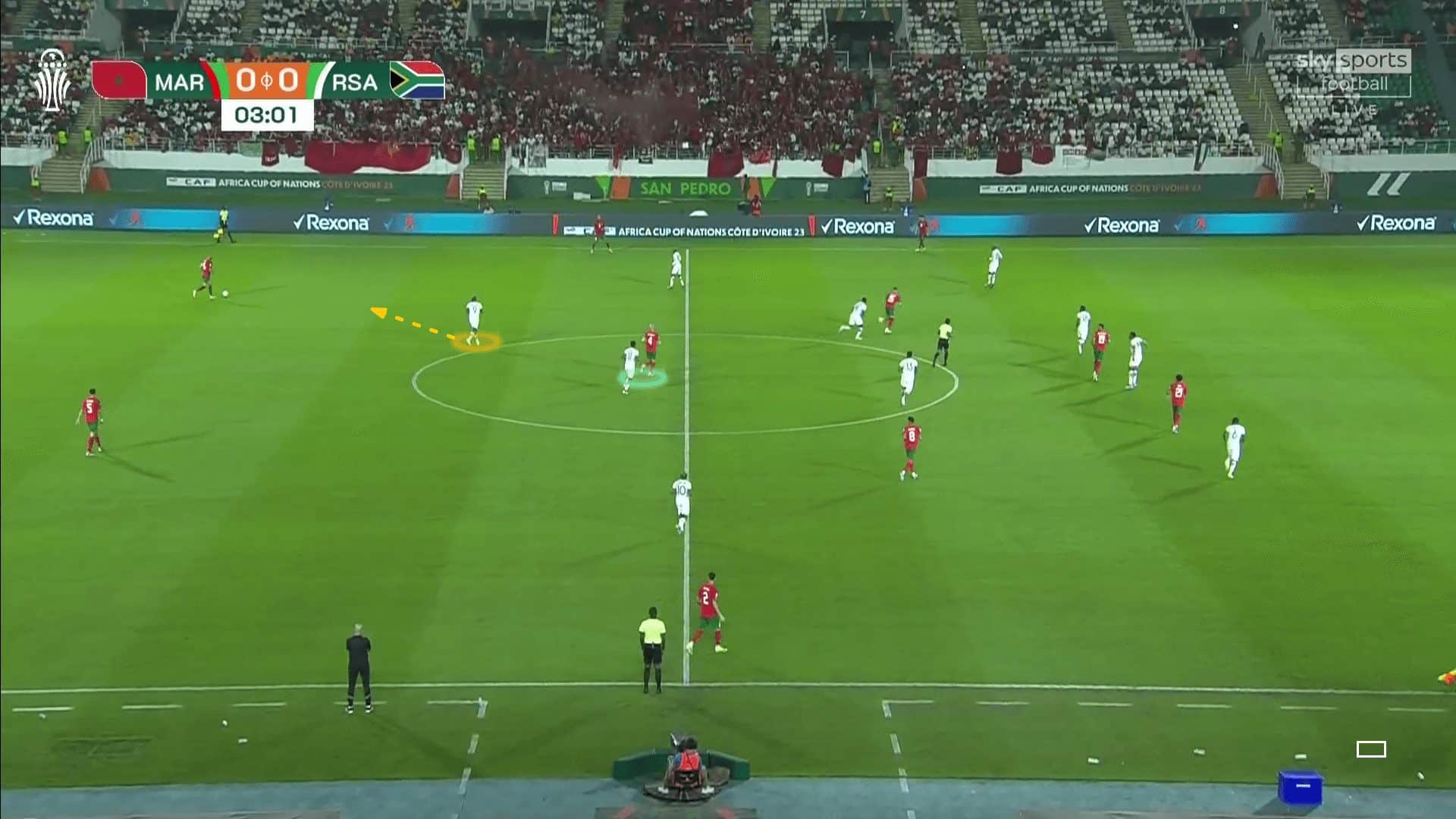
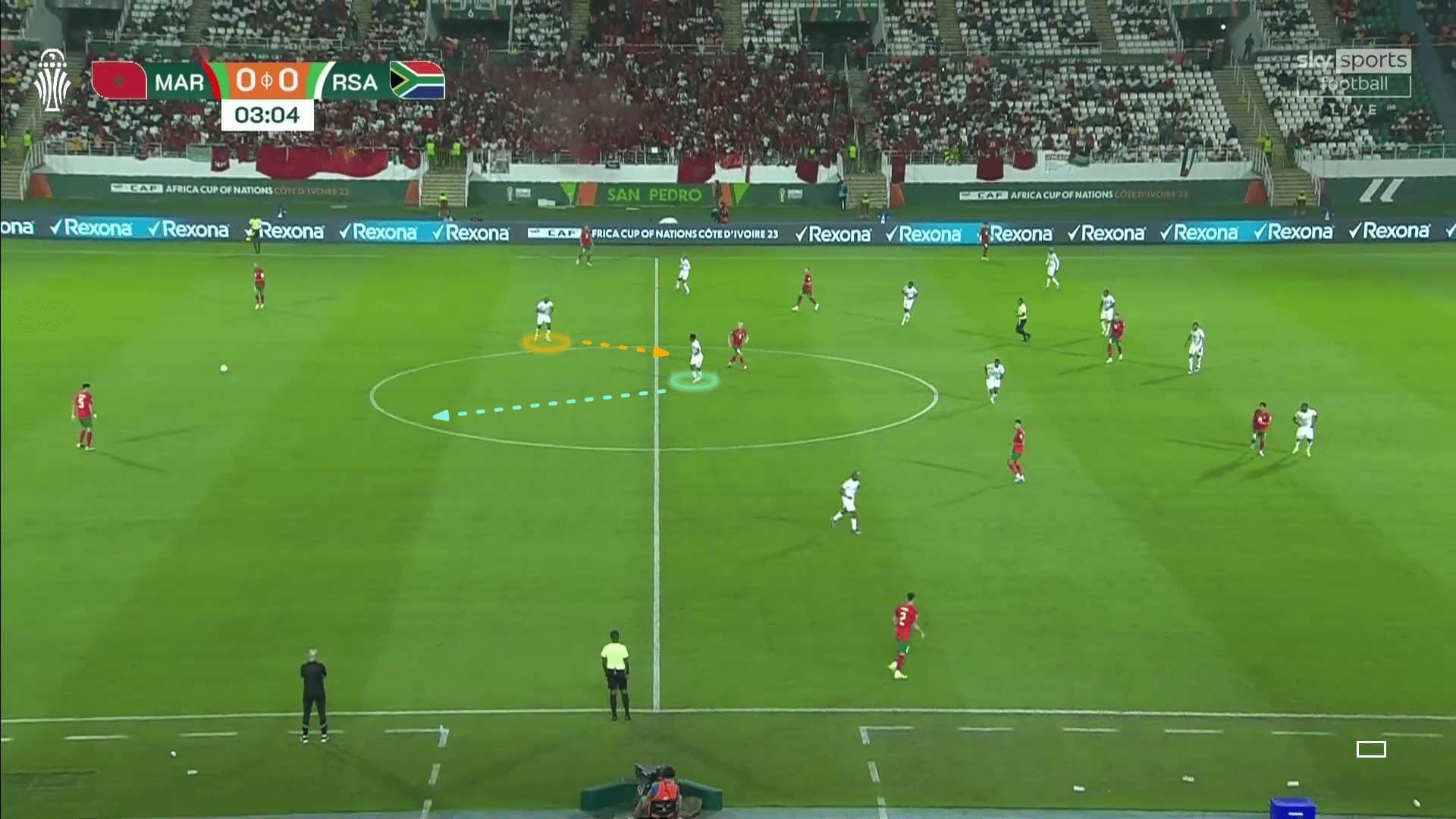
Morocco dealt with that by asking the midfielder near the ball to drop a little to take the attention of the winger to make Achraf Hakimi run behind him while the winger kept the full-back narrow.
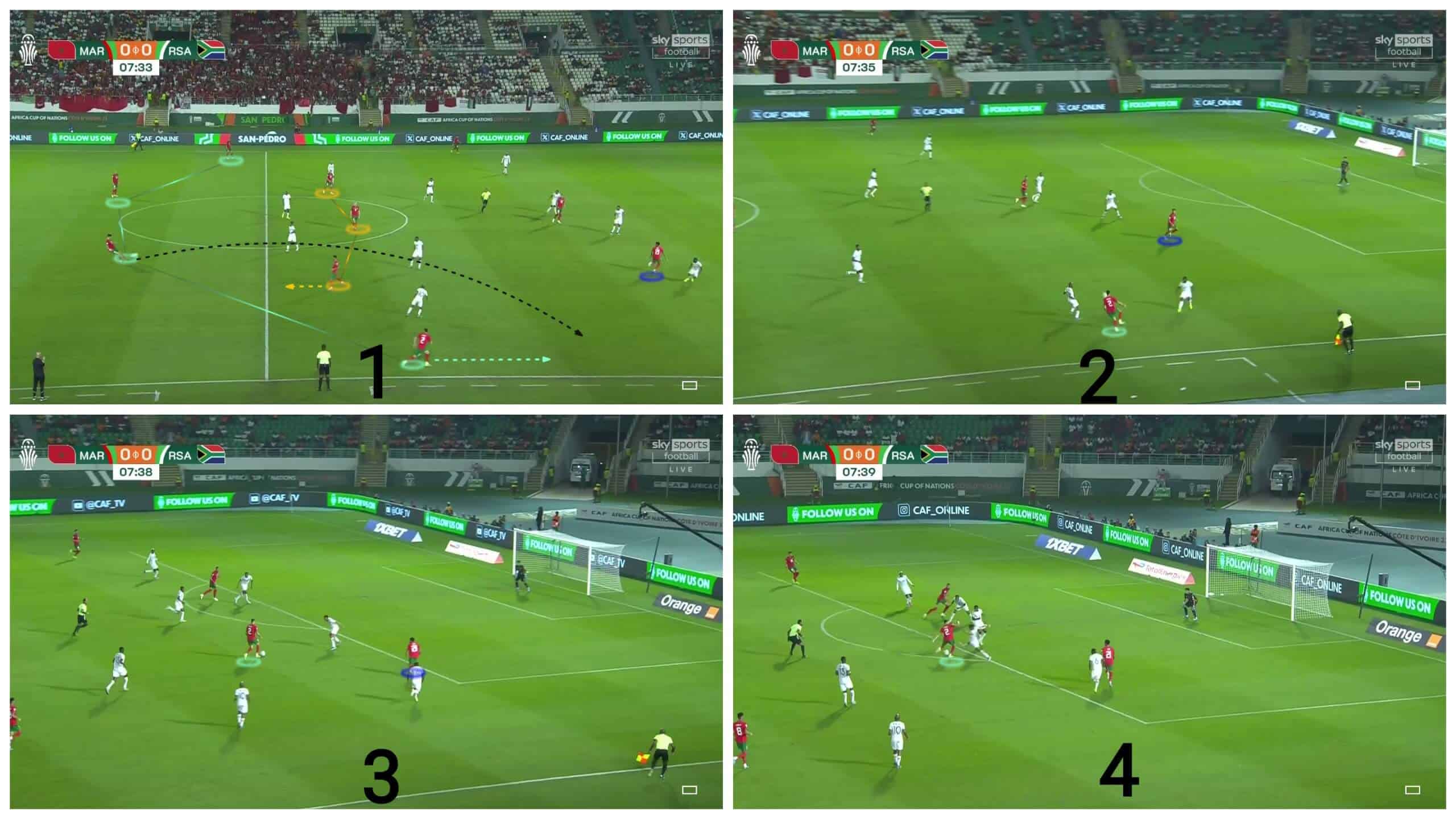
Morocco also had another idea: to make their holding midfielder, Sofyan Amrabat, drop to make three at the back while the two pivots fix South Africa’s two midfielders away from the ball side to empty the space for Hakimi who suddenly runs narrowly to receive, as shown in the first photo below. He passes the ball again to the empty pivot, who sends a through ball to the striker.
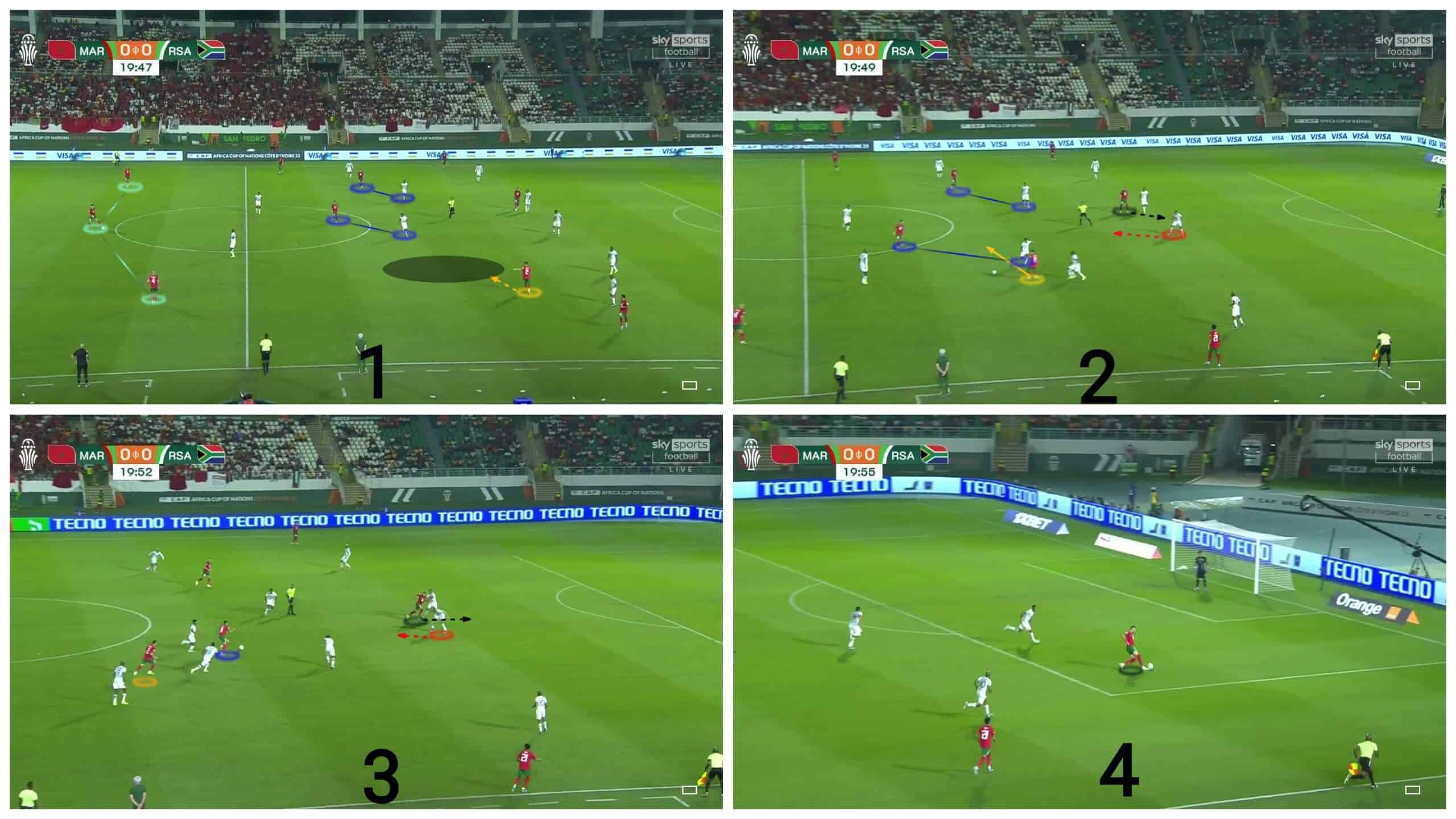
Ivory Coast
As we have mentioned, the hosts suffered and sacked their coach, Jean-Louis Gasset, after the final match in the group stages, but surprisingly, they could pass as one of the best third-place finishers thanks to the others’ help, especially Mozambique, who drew with Ghana late on. After that, Emerse Faé was named to take charge of the team on an interim basis.
Going to their journey during the tournament, they suffered at pressing because they play in 4-3-3 while their two attacking midfielders are easily dragged to empty the half spaces behind them.
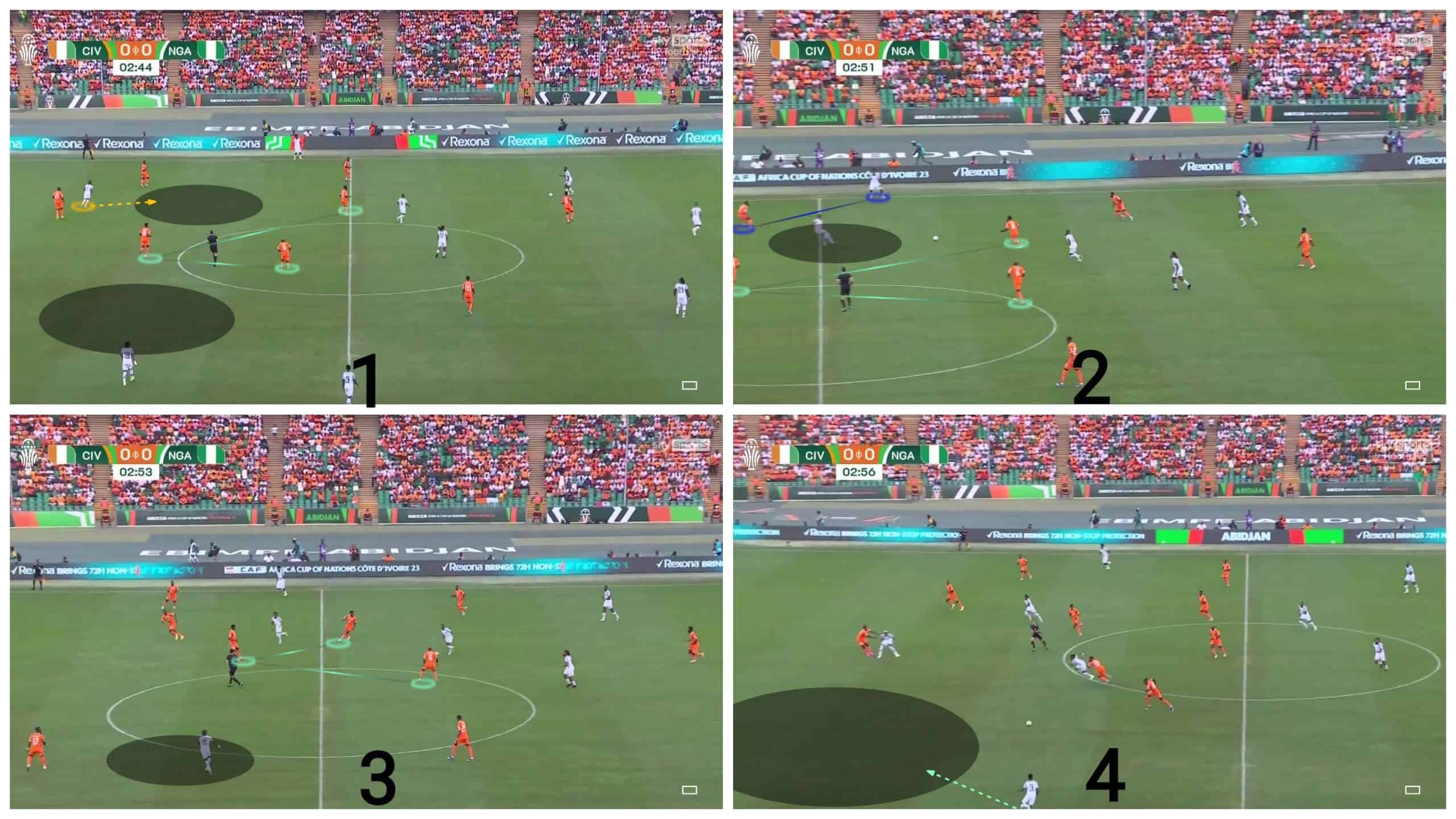
After that, Emerse Faé decided not to press high and stood in a narrow mid-block in a 4-5-1 shape, asking the striker to keep marking the opponent’s number six or by cover shadowing.
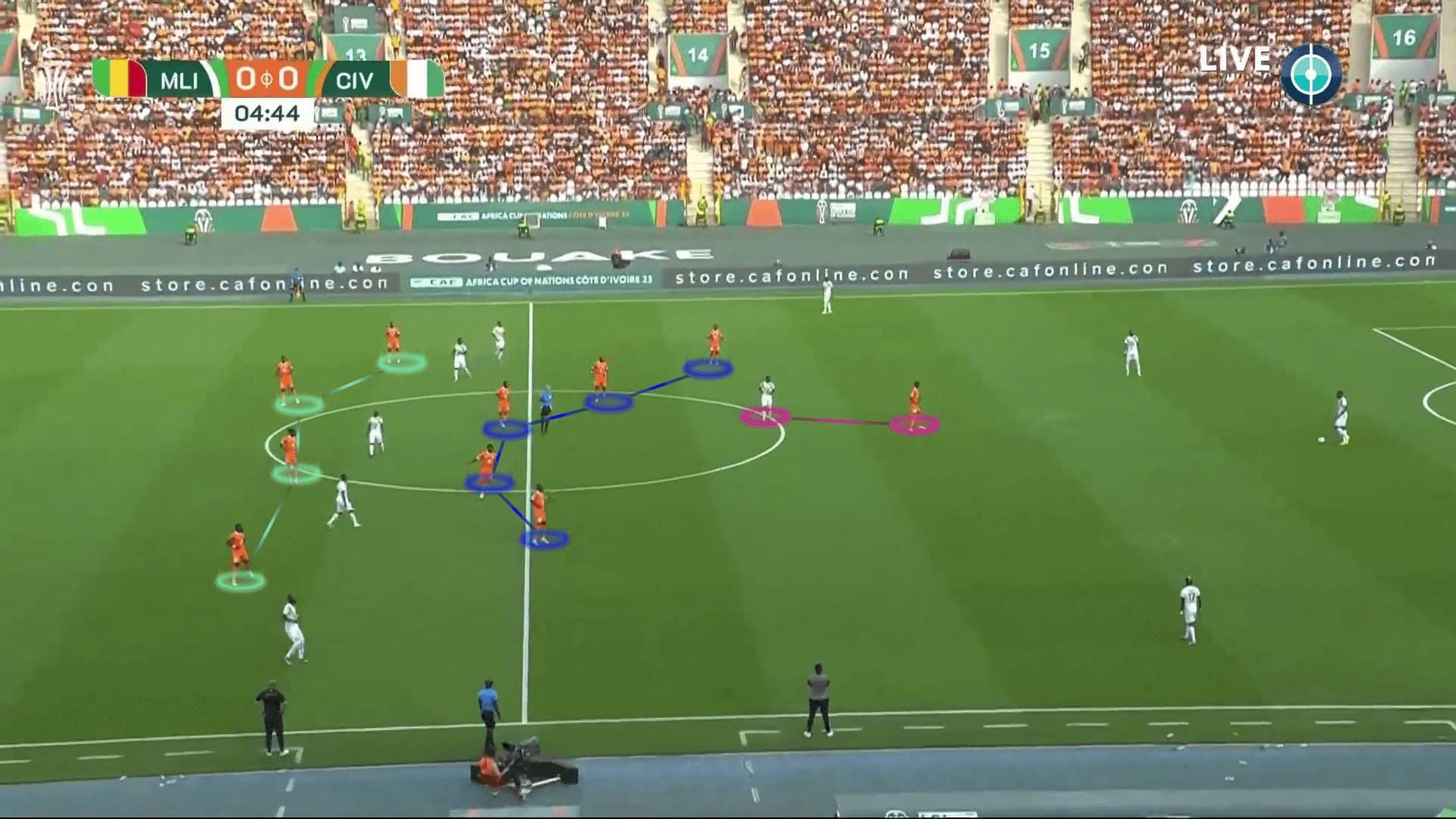
When they have the ball, you should look for Seko Fofana, whom they depend on heavily in most of their goals.
In the transition case below, you can find him having great awareness to move behind the opponent to receive the ball, dribble between two players and keep his ball in tight spaces to shoot a great shot scoring the first goal in the tournament.
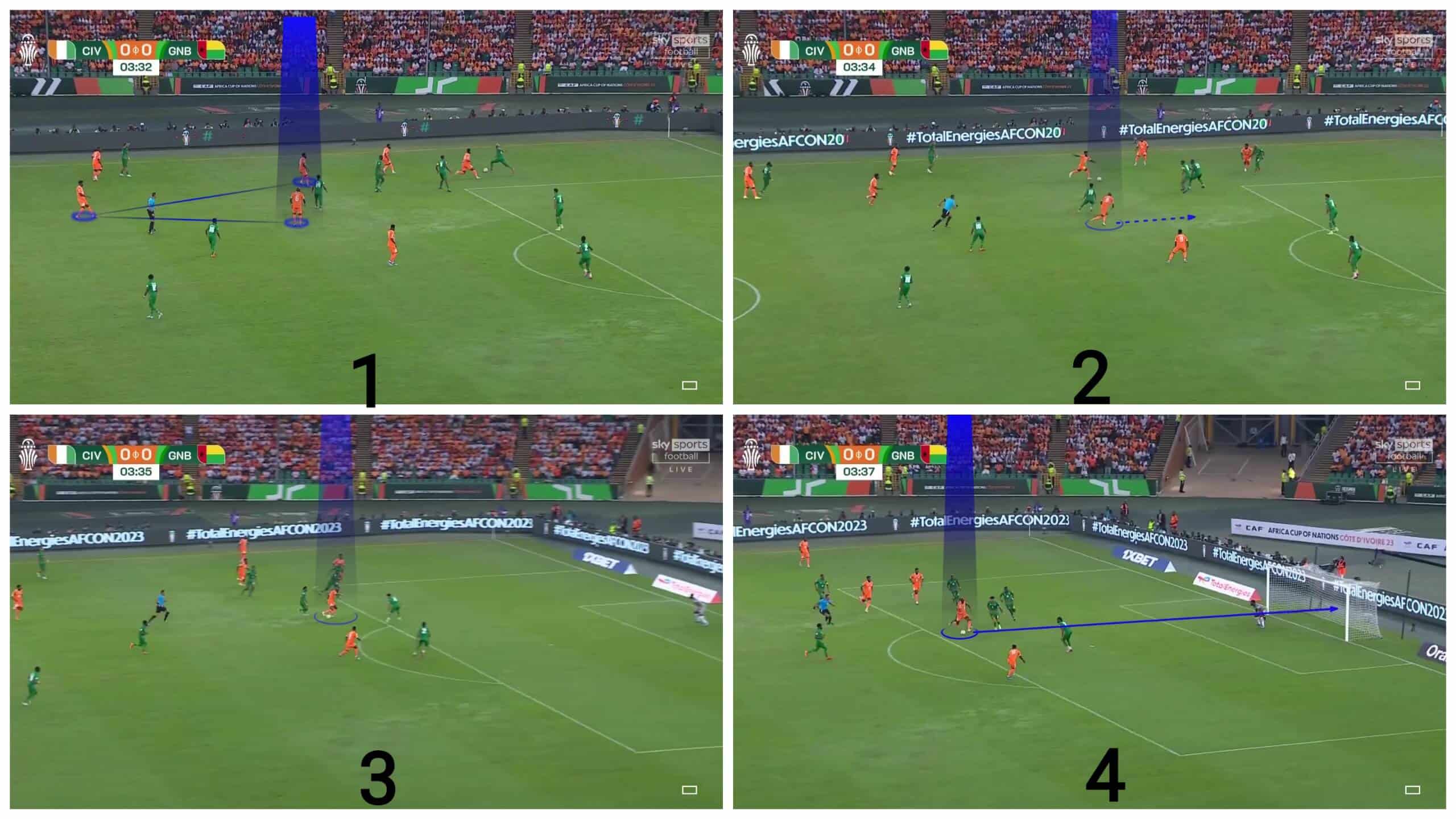
They exploit his excellent shooting, putting him around the box in set-pieces to shoot the rebound. The result is a killing goal in the last moments against Mali with the help of his mate, who touches the ball, as shown in the first and the second photos.
In the third and fourth photos, you can notice that he moves well to stand at the edge of the box to shoot, which leads, after that, to the first goal against Mali in the quarter-final.
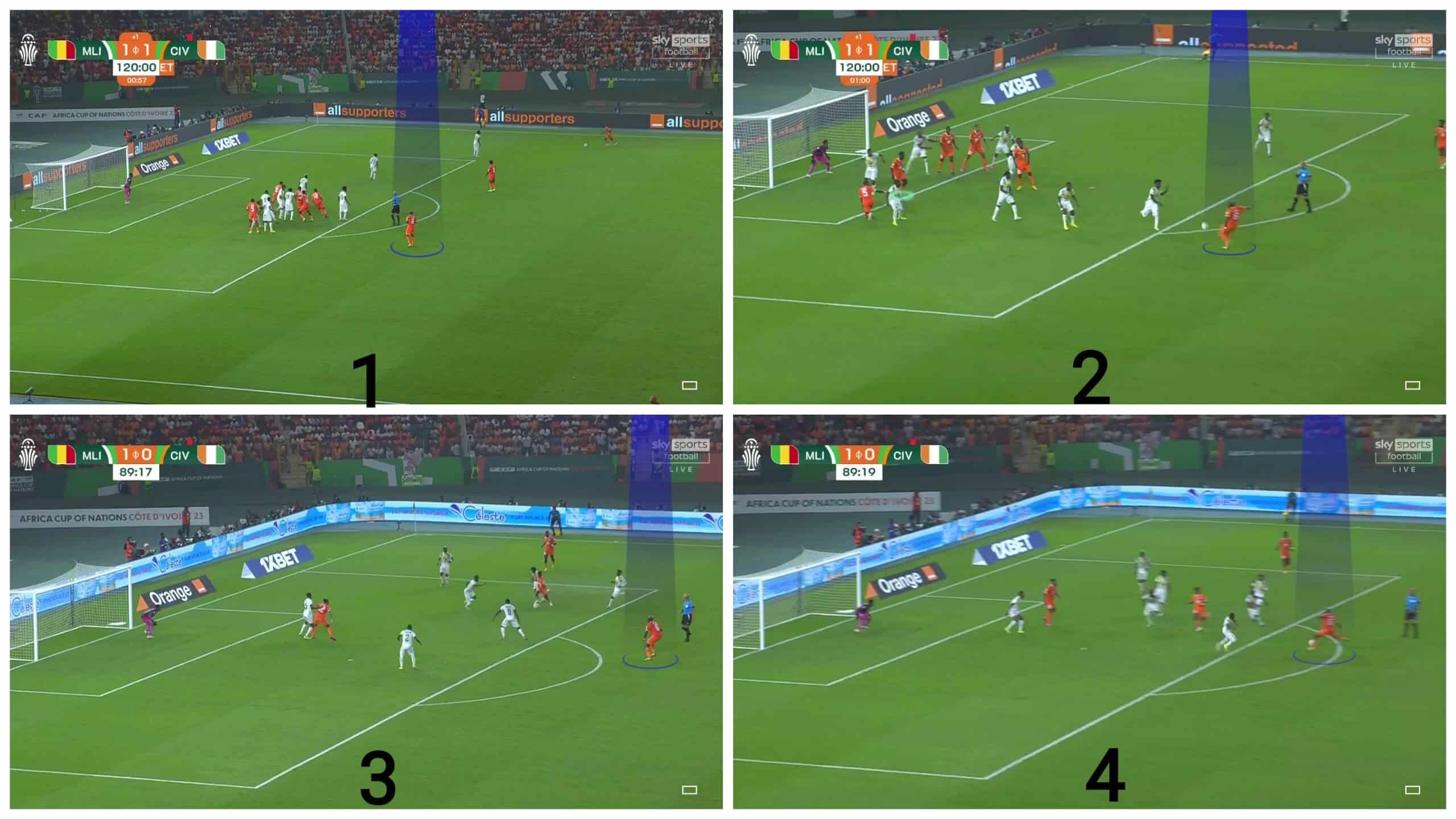
DR Congo
As we will explain, DR Congo attacks in 4-2-3-1 formations depending heavily on their number 10, Théo Bongonda, and their left winger, Yoane Wissa. In the first photo below, number 10 moves widely to receive the ball in the half-space, exploiting that Egypt’s two pivots press their two pivots while Wissa fixes the full-back and then runs behind him, as shown in the second photo below.
Théo Bongonda, number 10, can dribble for long distances to send a cross inside the box while the far winger cuts inside the box, as shown in the third and fourth photos.
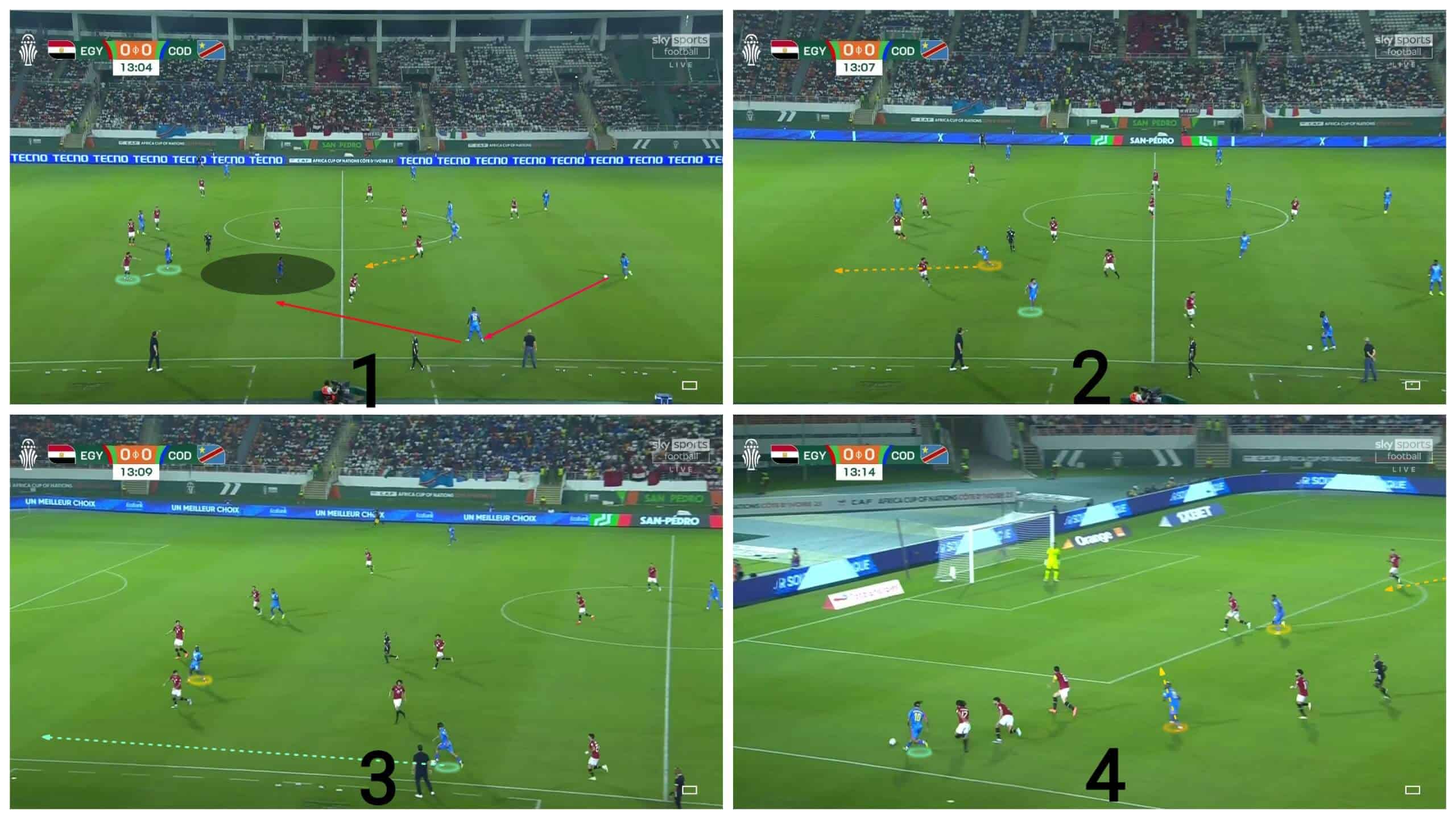
They also prefer to send longballs to their striker behind the opponent’s defence while the far winger, Wissa, cuts, scoring a goal against Zambia.
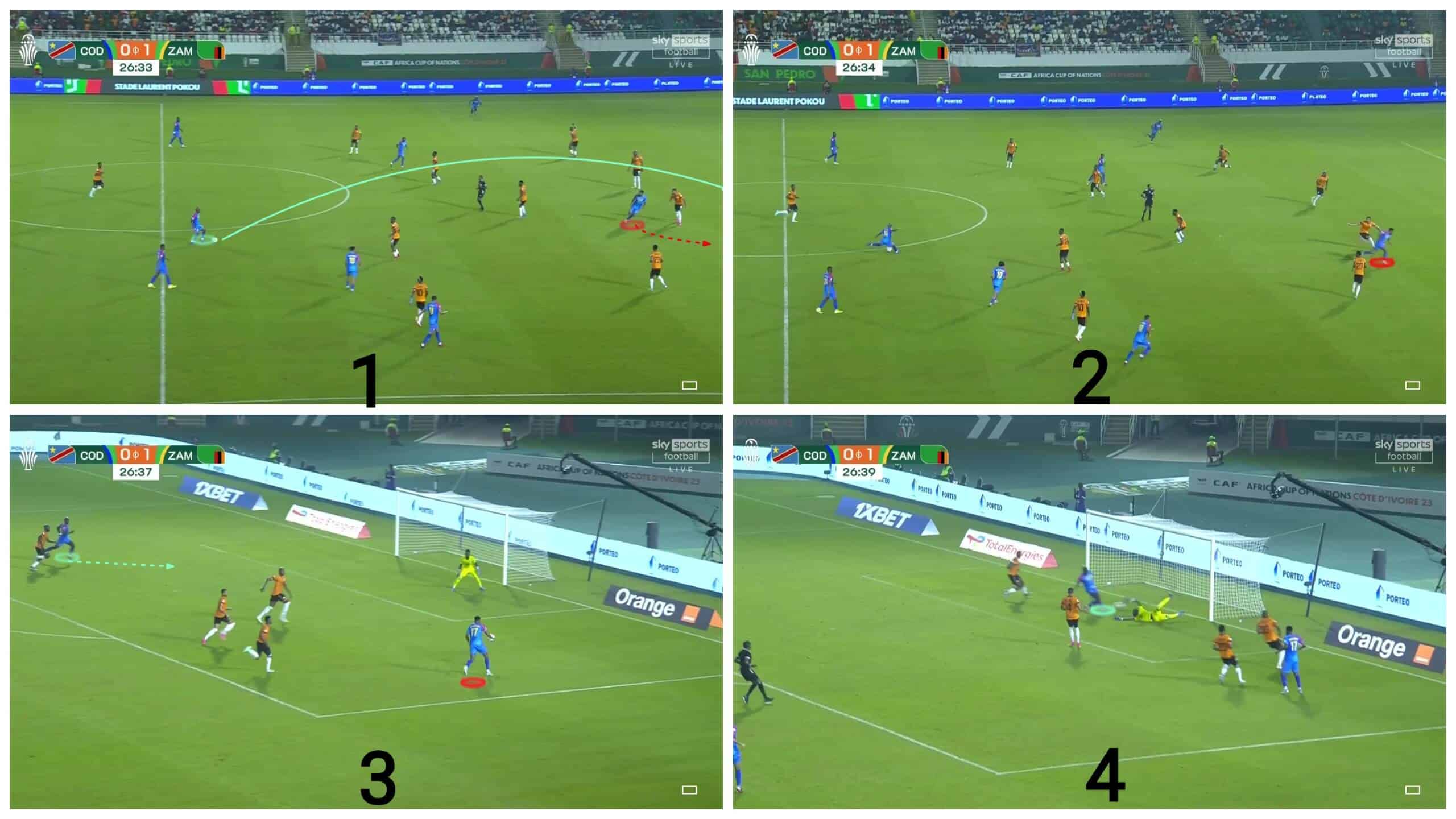
Out of the ball, they defend with 4-4-2, especially when the opponent uses two narrow midfielders in progression, as shown below.
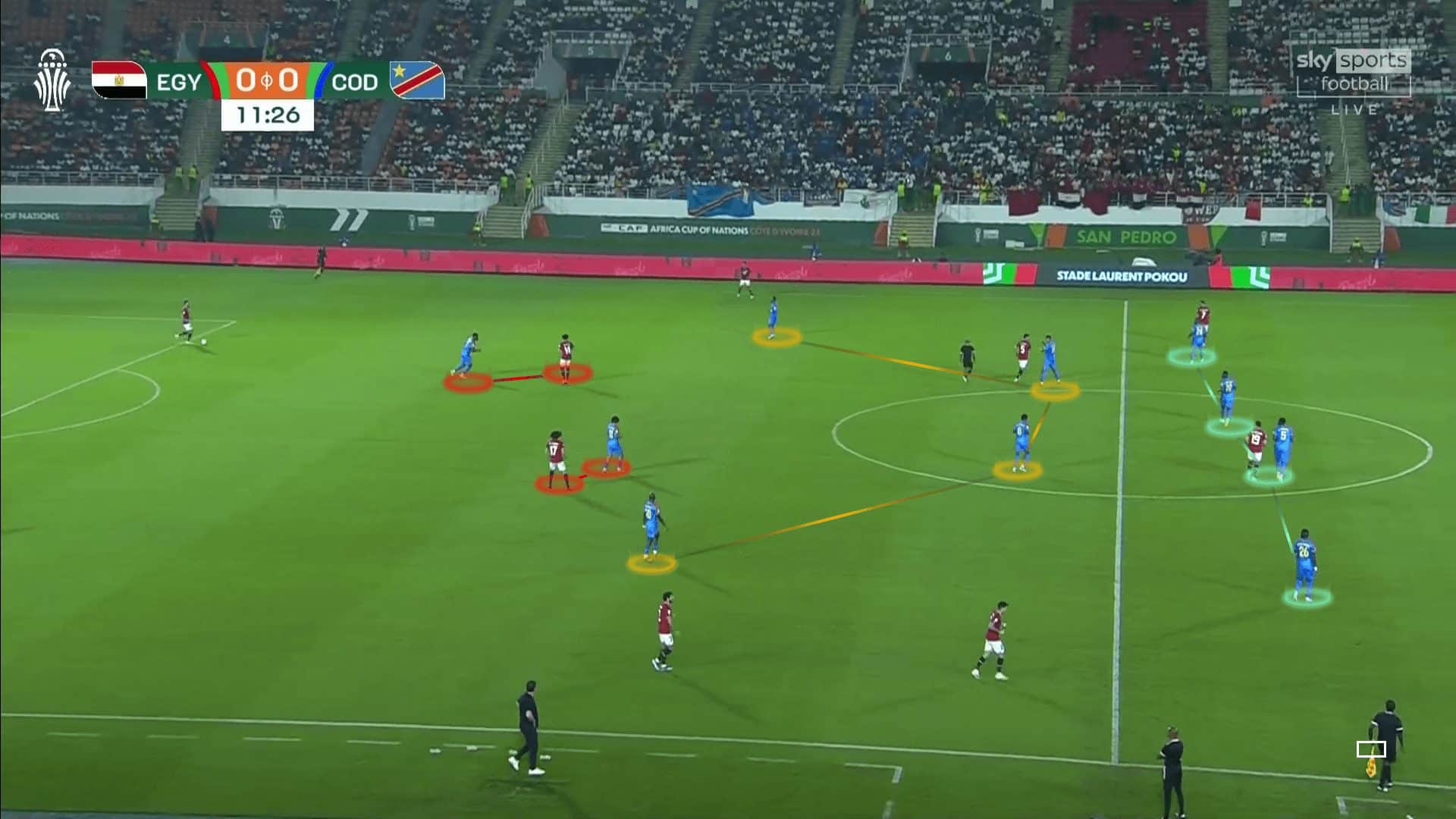
One of their weaknesses is defending against wing rotations, as in Egypt’s match, who use three players at wing rotations, especially at left. In the first photo, the winger drops to receive, in yellow, while the left midfielder, in green, stands between the midfielder and the full-back to fix them, which gives Egypt’s full-back the opportunity to overlap.
It forces the full-back to go up, so Egypt’s full-back passes a through ball to the midfielder behind him.
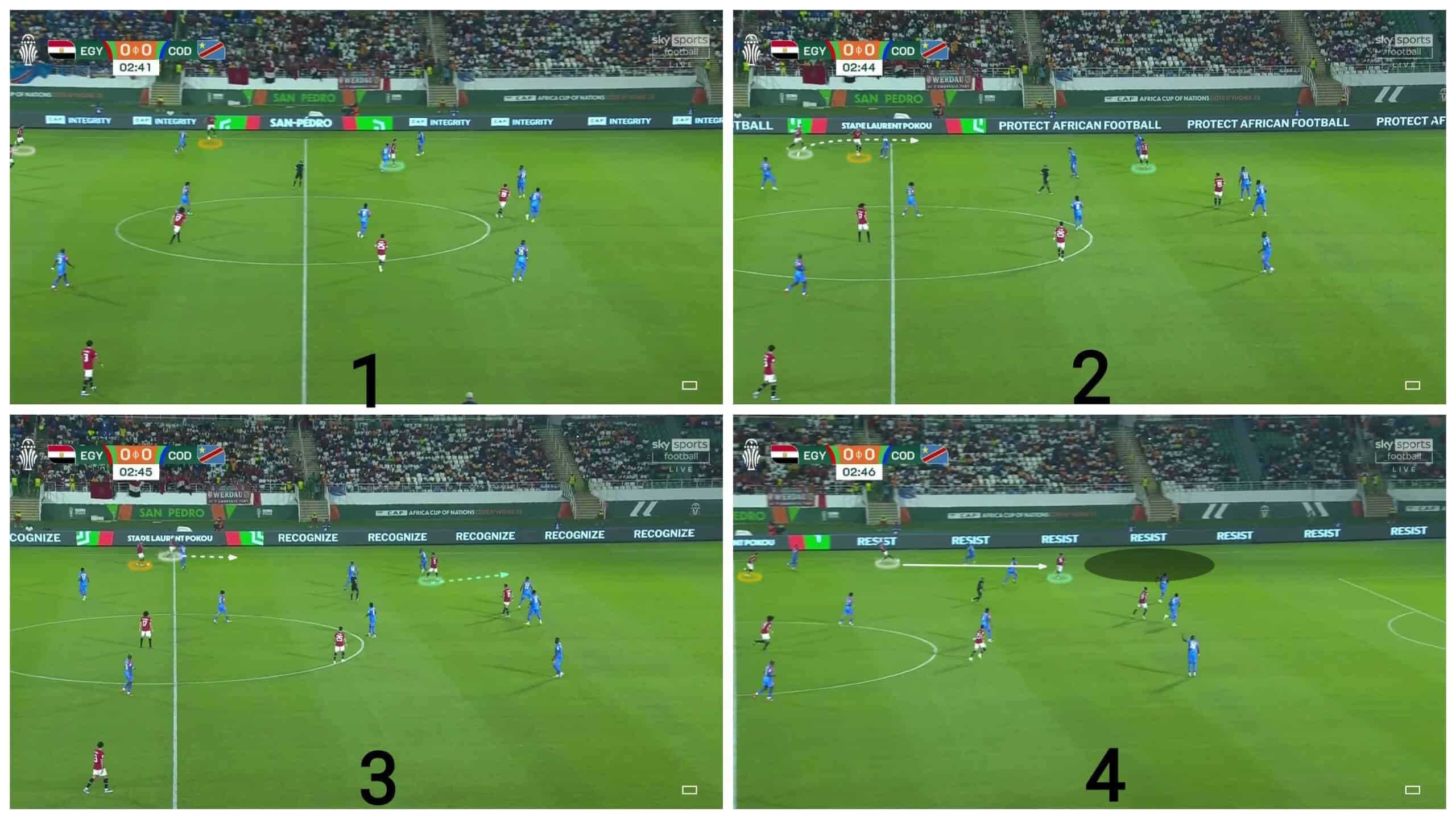
In the first photo below, Egypt use another wing rotation by asking the full-back, still in white, to keep narrow to receive the ball from the winger and pass it back to him when the opponent winger goes to press in the empty area thanks to the left midfielder who fixes the full-back and ready to run behind him when he faces the Egyptian winger who decides to dribble losing the ball, as shown in the fourth photo.
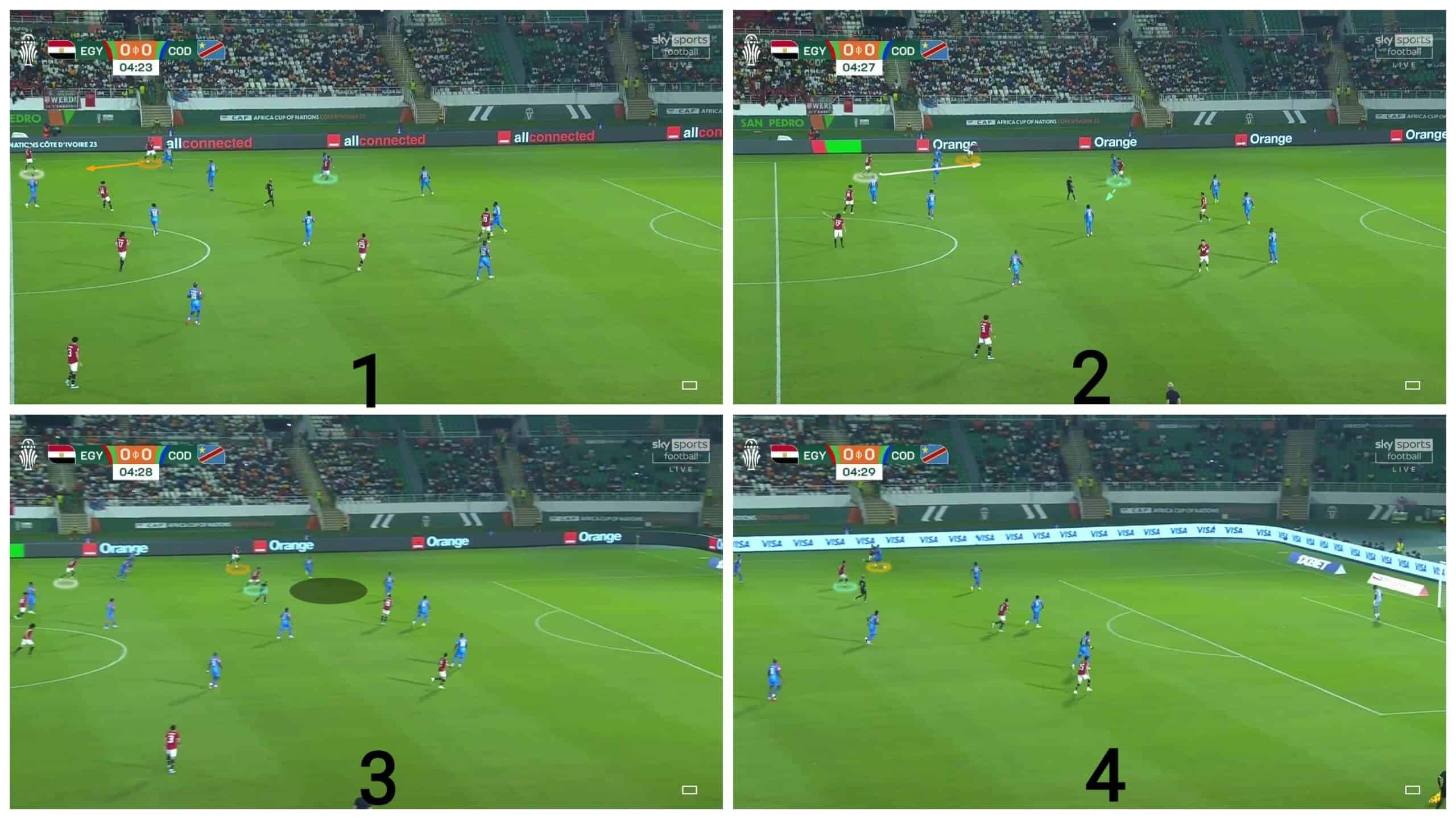
Conclusion
In this analysis, we have explained the most important styles of play of the four teams that qualified for the semi-finals of the African Cup Of Nations, highlighting the main strengths, weaknesses and influential players during their journey in the tournament.
In this scout report, we have also explained what they intend to do at attack and defence, showing the changes they made on that during the tournament.

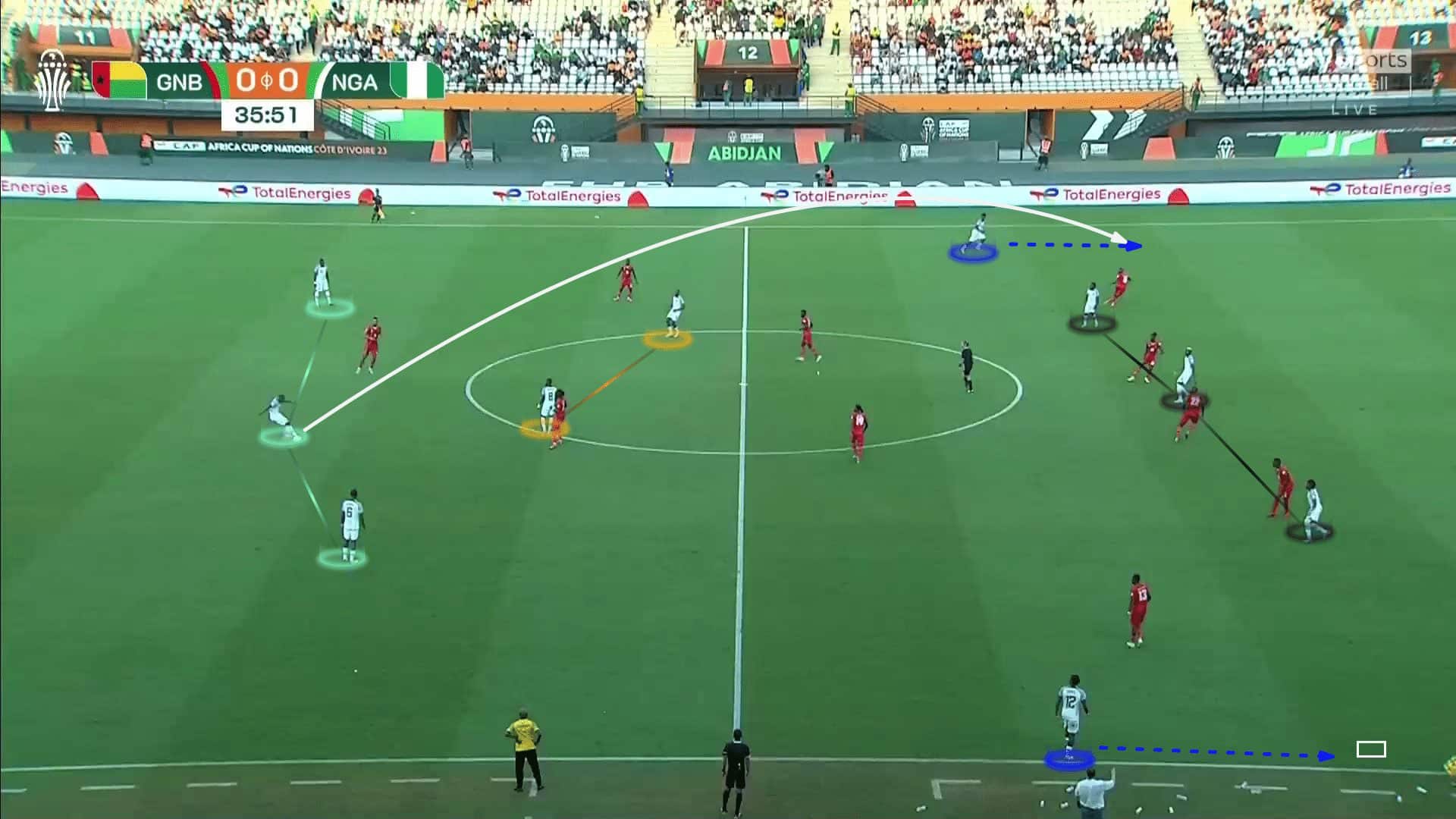




Comments